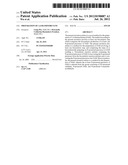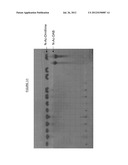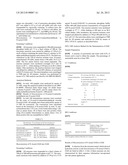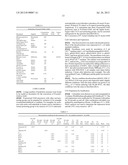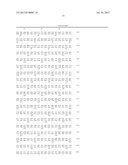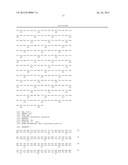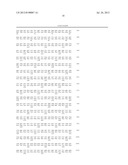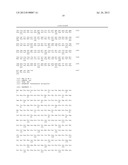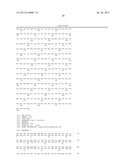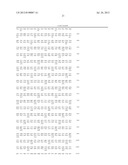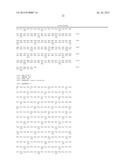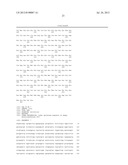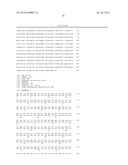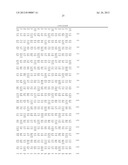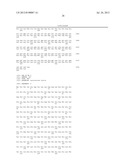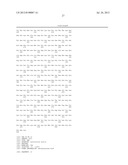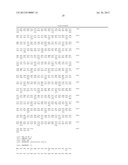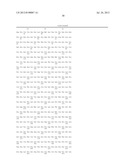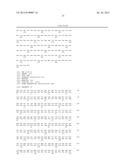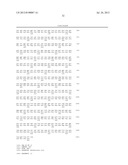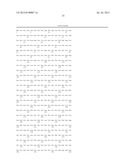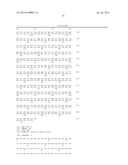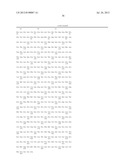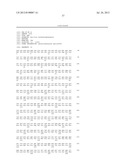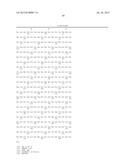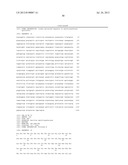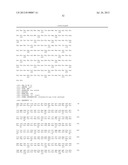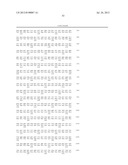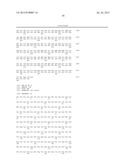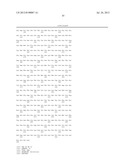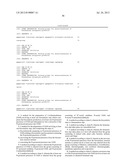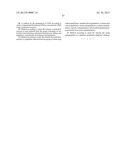Patent application title: PREPARATION OF 1,4-DIAMINOBUTANE
Inventors:
Liang Wu (Delft, NL)
Liang Wu (Delft, NL)
Petronella Catharina Raemakers-Franken (Budel, NL)
Petronella Catharina Raemakers-Franken (Budel, NL)
IPC8 Class: AC12P1300FI
USPC Class:
435128
Class name: Chemistry: molecular biology and microbiology micro-organism, tissue cell culture or enzyme using process to synthesize a desired chemical compound or composition preparing nitrogen-containing organic compound
Publication date: 2012-07-26
Patent application number: 20120190087
Abstract:
The present invention relates to a novel method for the preparation of
1,4-diaminobutane [DAB]. The method according to the present invention
involves at least one biocatalytic step which comprises the biocatalytic
production of at least one N-protected precursor of DAB. The present
invention also relates to a method for the preparation of DAB involving
at least one biocatalytic step, and comprising the steps of a)
biocatalytically preparing an N-protected precursor of DAB yielding
a--biocatalytic reaction mixture containing the N-protected precursor of
DAB, b) recovering the N-protected precursor from the biocatalytic
reaction mixture and c) converting the N-protected precursor into DAB.
More in particular, the present invention relates to a method for the
preparation of DAB, wherein the at least N-protected precursor of DAB is
selected from the group consisting of N5-protected ornithine, N-protected
DAB, and N-protected 4-aminobutyraldehyde.Claims:
1. A method for the preparation of 1,4-diaminobutane [DAB] involving at
least one biocatalytic step which comprises the biocatalytic production
of at least one N-protected precursor of DAB and subsequent in vitro
conversion of the N-protected precursor into DAB.
2. A method for the preparation of DAB involving at least one biocatalytic step, and comprising the steps of a) biocatalytically preparing an N-protected precursor of DAB yielding a biocatalytic reaction mixture containing the N-protected precursor of DAB, b) recovering the N-protected precursor from the biocatalytic reaction mixture c) converting the N-protected precursor into DAB.
3. A method according to claim 1, wherein the N-protected precursor of DAB is selected from the group consisting of N5-protected ornithine, N-protected DAB, and N-protected 4-aminobutyraldehyde.
4. A method according to claim 1, wherein the at least one N-protected precursor of DAB is selected from the group consisting of N5-acetyl ornithine, N-acetyl DAB, and N-acetyl 4-aminobutyraldehyde.
5. A method according to claim 1, wherein the biocatalytic step is a fermentation step
6. A method according to claim 5, wherein the fermentation step takes place in a unicellular host.
7. A method according to claim 6, wherein the fermentation step takes place in a host cell selected from the group consisting of animal cells, plant cells, bacteria, archaea, yeasts and fungi.
8. A method according to claim 2, wherein in the recovery of the N-protected precursor from the biocatalytic reaction mixture is carried out by at least one step selected from the group consisting of filtration, sedimentation, crystallization, affinity chromatography, size exclusion chromatography, membrane separation and evaporation
9. A method according to claim 2, wherein conversion step c) of the N-protected precursor into DAB involves at least one enzymatic or chemical treatment step.
10. A method for the preparation of DAB according to claim 1, wherein the N-protected DAB is converted into DAB using a hydrolytic enzyme.
11. Method according to claim 10, wherein a hydrolytic enzyme is used selected from the group consisting of carboxylic ester hydrolases, thiolester hydrolysases, lipases and peptidases, in particular from lipases and peptidases.
12. Method according to claim 10, wherein the hydrolytic enzyme is a peptidase selected from the group of serine-type carboxypeptidases, metallocarboxypeptidases, cysteine-type carboxypeptidases, serine endopeptidases, cysteine endopeptidases, aspartic endopeptidases and metalloendopeptidases, in particular from serine endopeptidases.
13. Method according to claim 12, wherein the serine endopeptidase is a subtilisin, preferably subtilisin Carlsberg.
Description:
[0001] The present invention relates to a method for the preparation of
1,4-diaminobutane [DAB] involving at least one biocatalytic step.
[0002] The compound DAB is an important raw material for the production of some of the major engineering plastics: polyamide-4,6, either in the form of a homopolymer, or copolymerized, for example, with about 5 wt. % of polyamide-6 monomer (caprolactam). The homopolymer polyamide-4,6 (nylon-4,6) was described as early as 1938 (U.S. Pat. No. 2,130,948, Carothers). It is the polycondensation product of the monomers DAB and adipic acid. Presently, especially compounds of polyamide-4,6 are being produced and sold by DSM in the Netherlands under the trade name STANYL®.
[0003] For the synthesis of DAB a number of chemical routes are known. These chemical routes suffer from the disadvantage that starting materials have to be obtained form sources that are considered to be non-renewable. There exists, however, a substantial need for providing new and feasible routes for the synthesis of DAB starting from renewable carbon sources and using biochemical processes (also referred to as "biotransformation").
[0004] A method for the preparation of DAB involving at least one fermentative step has been described in PCT applications published as WO2006/005603 and WO2006/00504. Both documents describe the fermentative production of DAB in a micro-organism having an increased level of an ornithine decarboxylase activity.
[0005] The present method relates to an alternative method for the preparation of DAB. The method according to the present invention involves at least one biocatalytic step which comprises the biocatalytic production of at least one N-protected precursor of DAB and subsequent in vitro conversion of the N-protected precursor into DAB.
[0006] It has been found that the recovery of DAB after biocatalytic production meets with considerable difficulties. In WO2007/079944 the recovery of an organic amine, such as DAB has been described. In a particular embodiment described therein, a cell-free broth containing a sulfate or phosphate salt of the amine (hence, e.g. DAB-disulfate) is concentrated, and a base, like ammonia is added. Depending on the conditions a two-layer system is formed. From the layer containing mainly the organic compounds, the desired amine can be recovered.
DETAILED DESCRIPTION OF THE INVENTION
[0007] According to one embodiment the method for the preparation of DAB involves at least one biocatalytic step, and comprises the steps of (a) biocatalytically preparing an N-protected precursor of DAB yielding a biocatalytic reaction mixture containing the N-protected precursor of DAB, (b) recovering the N-protected precursor from the biocatalytic reaction mixture, and (c) converting the N-protected precursor into DAB.
[0008] According to a particular embodiment the present invention for the production of DAB involves at least one biocatalytic step, which comprises the biocatalytic production of at least one N-protected precursor of DAB selected from the group consisting of N5-protected ornithine, N-protected DAB, and N-protected 4-aminobutyraldehyde and subsequent in vitro conversion of the N-protected precursor into DAB.
[0009] With "in vitro conversion" is meant here conversion of an N-protected precursor of DAB into DAB in a medium outside a cell. The in vitro conversion can be a conversion by at least one biocatalyst or can be a chemical conversion involving at least one chemical step, or can be a combination of at least one biocatalytic and at least one chemical step.
[0010] With an "N-protected precursor of DAB" is meant here a compound containing a protected amino group and which can be converted into DAB by way of at least one chemical or biocatalytic reaction or a combination of chemical and biocatalytic reactions.
[0011] With "N5-protected ornithine" is meant here the ornithine molecule which has a protecting group at its N5 atom; with "N-protected DAB" is meant here the DAB molecule which has a protecting group at one of its amino groups; and with "N-protected 4-aminobutyraldehyde" is meant here the 4-aminobutyraldehyde molecule which has a protecting group at the amino group.
[0012] The protecting groups referred to above may be selected from the group consisting of acyl species having 1-6 carbon atoms or may be a guanidyl group. Such a protecting group should be selected to allow for at least one of biocatalytic production, ease of recovery of the N-protected precursor from the biocatalytic reaction mixture (e.g. fermentation broth) and subsequent biocatalytic and/or chemical reactions to ultimately produce DAB.
[0013] N-protected DAB precursors can be prepared by acylation of for example 4-aminobutyraldehyde or ornithine. For examples, by acylation with acetic acid anhydride in formic acid to introduce a formyl protecting group or by reaction of C2-C6 carboxylic acid anhydrde or acyl chloride to introduce a N-acetyl, N-propionyl, N-butyryl, N-valeryl or N-caproyl protecting group, respectively.
[0014] N-guanidyl protected precursors are for example the proteinogenic arginine or N-guanidyl-aminobutyraldehyde or N-guanidyl-DAB. A fermentative route is described, for example, in EP1260588, which describes the biochemical production of agmatine from arginine under influence of an arginine decarboxylase. Agmatine is N-guanidyl-protected DAB. Agmatine (N-guanidyl-protected DAB) can be smoothly deprotected to DAB by acidic hydrolysis, for instance by refluxing agmatine in an aqueous concentrated mineral acid solution such as concentrated hydrochloric or sulfuric acid. This gives the diacid salt of DAB and the by-products carbon dioxide and ammonia (the latter in the form of its ammonium salt of the mineral acid which is used). To obtain the DAB in its free amine form, the formed diacid salt should be isolated, redissolved and neutralized with a base.
[0015] According to a further particular embodiment the invention relates to a method for the preparation of DAB wherein at least one N-protected precursor of DAB is produced, which N-protected precursor is selected from the group consisting of N5-acetyl ornithine, N-acetyl DAB, and N-acetyl 4-aminobutyraldehyde.
[0016] According to one particular embodiment the method for the preparation of DAB involving at least one biocatalytic step comprises the steps of (a) biocatalytically preparing N5-acetyl ornithine yielding a biocatalytic reaction mixture containing N5-acetyl ornithine, (b) recovering N5-acetyl ornithine from the biocatalytic reaction mixture, and (c) converting N5-acetyl ornithine into DAB.
[0017] According to one particular embodiment the method for the preparation of DAB involving at least one biocatalytic step comprises the steps of (a) biocatalytically preparing N-acetyl DAB yielding a biocatalytic reaction mixture containing N-acetyl DAB, (b) recovering N-acetyl DAB from the biocatalytic reaction mixture, and (c) converting N-acetyl DAB into DAB.
[0018] According to one particular embodiment the method for the preparation of DAB involving at least one biocatalytic step comprises the steps of (a) biocatalytically preparing N-acetyl 4-aminobutyraldehyde yielding a biocatalytic reaction mixture containing N-acetyl 4-aminobutyraldehyde, (b) recovering N-acetyl 4-aminobutyraldehyde from the biocatalytic reaction mixture, and (c) converting N-acetyl 4-aminobutyraldehyde into DAB.
[0019] When referred herein explicitly or implicitly to an amine or an N-protected amine, e.g. N-protected DAB, these terms are meant to include the neutral amine group, the corresponding charged protonated amine as well as salts thereof.
DEFINITIONS
[0020] The term "or" as used herein is defined as "and/or" unless specified otherwise.
[0021] The term "a" or "an" as used herein is defined as "at least one" unless specified otherwise.
[0022] When referring to a noun (e.g. a compound, an additive, etc.) in the singular, the plural is meant to be included.
[0023] When referring to a compound of which stereoisomers exist, the compound may be any of such stereoisomers or a combination thereof. Thus, when referred to, e.g., an amino acid of which enantiomers exist, the amino acid may be the L-enantiomer or the D-enantiomer or a combination thereof. In case a natural stereoisomer exists, the compound is preferably a natural stereoisomer.
[0024] When an enzyme is mentioned with reference to an enzyme class (EC) between brackets, the enzyme class is a class wherein the enzyme is classified or may be classified on the basis of the Enzyme Nomenclature provided by the Nomenclature Committee of the International Union of Biochemistry and Molecular Biology (NC-IUBMB), which nomenclature may be found at http://www.chem.qmul.ac.uk/iubmb/enzyme/. Other suitable enzymes that have not (yet) been classified in a specified class but may be classified as such, are meant to be included.
[0025] The term "homologous" or "homolog" or "ortholog" refers to related sequences that have a functional relationship and is generally determined based on degree of sequence identity. These terms may describe the relationship between a gene found in one species, subspecies, variety, cultivar or strain and the corresponding or equivalent gene in another species, subspecies, variety, cultivar or strain. They may also describe the relationship between a gene found in nature and an artificially constructed gene, or between two artificially constructed genes. A functional relationship may be indicated in any one of a number of ways, including, but not limited to, (a) degree of sequence identity; (b) same or similar biological function. Preferably, both (a) and (b) are indicated. The term homolog is also meant to include nucleic acid sequences (polynucleotide sequences) which differ from another nucleic acid sequence due to the degeneracy of the genetic code and encode the same polypeptide sequence.
[0026] Wherever the term "homolog" is used herein in relation to a polypeptide, this is intended to indicate a polypeptide having the same or a similar biological function and a sequence identity of a certain degree with a reference polypeptide. In particular it is intended to indicate a sequence identity of at least 30%, preferably at least 40%, more preferably at least 60%, more preferably at least 65%, more preferably at least 70%, more preferably at least 75%, more preferably at least 80%, in particular at least 85%, more in particular at least 90%, at least 91%, at least 92%, at least 93%, at least 94%, at least 95%, at least 96%, at least 97%, at least 98% or at least 99%.
[0027] "Sequence identity" or "sequence similarity" is herein defined as a relationship between two or more polypeptide sequences or two or more nucleic acid sequences, as determined by comparing the sequences. Usually, sequence identities or similarities are compared over the whole length of the sequences, but may however also be compared only for a part of the sequences aligning with each other. In the art, "identity" or "similarity" also means the degree of sequence relatedness between polypeptide sequences or nucleic acid sequences, as the case may be, as determined by the match between such sequences. Preferred methods to determine identity or similarity are designed to give the largest match between the sequences tested. In context of this invention a preferred computer program method to determine identity and similarity between two sequences includes BLASTP and BLASTN (Altschul, S. F. et al., J. Mol. Biol. 1990, 215, 403-410, publicly available from NCBI and other sources (BLAST Manual, Altschul, S., et al., NCBI NLM NIH Bethesda, Md. 20894). Preferred parameters for polypeptide sequence comparison using BLASTP are gap open 10.0, gap extend 0.5, Blosum 62 matrix. Preferred parameters for nucleic acid sequence comparison using BLASTN are gap open 10.0, gap extend 0.5, DNA full matrix (DNA identity matrix).
[0028] With "biotransformation" or "biocatalytic reaction" is meant here a biochemical reaction wherein an enzyme is used as a catalyst. Wherever in accordance with the invention herein, it is indicated that a biocatalyst is used, at least one reaction step in the method is catalyzed by a biological material or moiety derived from a biological source, for instance an organism or a biomolecule derived there from. In particular, the biotransformation may be a fermentation step. The biocatalyst may in particular comprise one or more enzymes. The biocatalyst may be used in any form. In a particular embodiment, one or more enzymes are used isolated from the natural environment (isolated from the organism it has been produced in), for instance as a solution, an emulsion, a dispersion, (a suspension of) freeze-dried cells, as a lysate, or immobilized on a support. In an embodiment, one or more enzymes form part of a living organism (such as living whole cells). The enzymes may perform a catalytic function inside the cell. It is also possible that the enzyme may be secreted into a medium, wherein the cells are present.
[0029] With "biocatalytic reaction mixture" is meant here the environment in which the biocatalytic reaction takes place. This may be a cellular environment (for intracellular or extracellular biocatalytic reactions) or a cell-free environment.
[0030] With "fermentative step" is meant here a process step wherein the formation or conversion of a particular chemical entity takes place in a unicellular host, more in particular in a micro-organism in a cell culture. "Fermentatively preparing" means here producing a particular chemical entity in a micro-organism comprising a biocatalyst in a cell culture with a fermentable carbon source, wherein the carbon source contains any of said compounds which are to be converted into the particular chemical entity to be prepared or wherein the cells prepare the compound to be converted into the particular chemical entity to be prepared from the carbon source. The micro-organism may be a natural producer of the particular chemical entity or it may have obtained the capability to produce the particular chemical entity by transformation with a gene encoding at least one suitable enzyme using recombinant DNA techniques. The natural producer of the particular chemical entity may also be transformed with a gene encoding at least one suitable enzyme using recombinant DNA technology in order to increase the production of the desired particular chemical entity and/or to diminish the production of components which could interfere with the productivity of the desired particular chemical entity or which would interfere with the further steps in the process according to the present invention.
[0031] Preferred micro-organisms for fermentatively preparing the N-protected precursor of DAB may be of eukaryotic or prokaryotic origin. In particular it may be selected from animal (including human) cells, plant cells, bacteria, archaea, yeasts and fungi. More in particular the micro-organism may be selected from the group consisting of bacteria, such as Bacillus (in particular B. subtilis), Brevibacterium (in particular B. ketoglutamicum), corynebacteria (in particular C. glutamicum), Escherichia (in particular E. coli), Klebsiella (in particular K. pneumoniae), lactobacilli (in particular L. lactis), propionibacterium, pseudomonas (in particular P. putida), Rodococcus (in particular R. erythropolis, Streptomyces (in particular S. coelicor and S. clavuligerus), yeasts such as Kluyveromyces (in particular K. lactis), Penicillium (in particular P. chrysogenum), Saccharomyces (in particular S. cerevisiae), Aspergillus (in particular A. niger), Pichia (in particular P. pastoris), Hansenula, Schizosaccharomyces (in particular S. pombe), Yarowia (in particular Y. lypolytica), fungi, such as Talaromyces.
[0032] In the most preferred embodiment, the fermentative production of the N-protected precursor is performed in a micro-organism wherein the N-protected precursor is being formed in vivo. Preferably, the formation of the N-protected precursor according to the present invention is a biotransformation into the N-protected precursor from any suitable carbon source.
[0033] The carbon source for the fermentation process may in particular contain at least one compound selected from the group of monohydric alcohols, polyhydric alcohols, carboxylic acids, carbon dioxide, fatty acids, glycerides, including mixtures comprising any of said compounds. Suitable monohydric alcohols include methanol and ethanol, Suitable polyols include glycerol and carbohydrates. Suitable fatty acids or glycerides may in particular be provided in the form of edible oil, preferably of plant origin.
[0034] In particular a carbohydrate may be used, because usually carbohydrates can be obtained in large amounts from a biologically renewable source, such as an agricultural product, preferably an agricultural waste-material. Preferably a carbohydrate is used selected from the group of glucose, fructose, sucrose, lactose, saccharose, starch, cellulose and hemi-cellulose. Particularly preferred are glucose, oligosaccharides comprising glucose and polysaccharides comprising glucose.
[0035] Also, as a carbon source may be used amino acids or derivatives thereof, glutamate or derivatives thereof and/or ornithine or derivatives thereof.
[0036] As nitrogen source may be used inorganic nitrogen-containing compounds, such as ammonia, ammonia salts, ureum, nitrate and nitrite, or organic nitrogen-containing compounds, such as amino acids or derivatives thereof, more in particular glutamate or derivatives thereof and/or ornithine or derivatives thereof.
[0037] When reference is made here to a biocatalyst it may refer to an organism expressing at least one enzyme relevant for the biocatalytic function, or it may refer to at least one enzyme obtained or derived from an organism. The organism may be eukaryotic or prokaryotic. In particular the organism may be selected from animals (including humans), plants, bacteria, archaea, yeasts and fungi.
[0038] In one embodiment the biocatalyst originates from an animal, in particular from a part thereof--e.g. liver, pancreas, brain, kidney, heart or other organ. The animal may in particular be selected from the group of mammals, more in particular selected from the group of primates (like Homo sapiens), Leporidae, Muridae, Suidae and Bovidae.
[0039] Suitable plants as origin of the biocatalyst are, in particular, plants selected from the group of Asplenium; Cucurbitaceae, in particular Cucurbita, e.g. Cucurbita moschata (squash), or Cucumis; Mercurialis, e.g. Mercurialis perennis; Hydnocarpus; and Ceratonia.
[0040] Suitable bacteria as origin of the biocatalyst may in particular be selected amongst the group of Acinetobacter, Agrobacterium, Alcaligenes, Bacillus, Brevibacterium, Clostridium, Corynebacterium, Deinococcus, Enterobacter, Enterococcus, Erwinia, Escherichia, Geobacillus, Klebsiella, Lactobacillus, Lactococcus, Legionella, Mycobacterium, Neisseria, Nitrosomonas, Novosphingobium, Paracoccus, Proteus, Pseudomonas, Ralstonia, Rhodobacter, Rhodopseudomonas, Salmonella, Shigella, Staphylococcus, Streptococcus, Streptomyces, Thermus, Vibrio and Zymomonas.
[0041] Suitable archaea as origin of the biocatalyst may in particular be selected amongst the group of Aeropyrum, Archaeoglobus, Halobacterium, Methanobacterium, Methanobrevibacter, Methanocaldococcus, Methanococcus, Methanopyrus, Methanosarcina, Methanosphaera, Pyrobaculum and Thermoplasma.
[0042] Suitable fungi as origin of the biocatalyst may in particular be selected amongst the group of Aspergillus, Neurospora, Penicillium, Rhizopus and Trichoderma.
[0043] A suitable yeast as origin of the biocatalyst may in particular be selected amongst the group of Candida, Cytophagia, Hansenula, Humicola, Kluyveromyces, Mucor, Rhizoctonia, Saccharomyces and Yarrowia.
[0044] It will be clear to the person skilled in the art that use can be made of a naturally occurring biocatalyst (wild type) or a mutant of a naturally occurring biocatalyst with suitable activity in a method according to the invention. Properties of a naturally occurring biocatalyst may be improved by biological techniques known to the skilled person in the art, such as e.g. molecular evolution or rational design. Mutants of wild-type biocatalysts can for example be made by modifying the encoding DNA of an organism capable of acting as a biocatalyst or capable of producing a biocatalytic moiety (such as an enzyme) using mutagenesis techniques known to the person skilled in the art (random mutagenesis, site-directed mutagenesis, directed evolution, gene recombination, etc.). In particular the DNA may be modified such that it encodes an enzyme that differs by at least one amino acid from the wild-type enzyme, so that it encodes an enzyme that comprises one or more amino acid substitutions, deletions and/or insertions compared to the wild-type, or such that the mutants combine sequences of two or more parent enzymes or by effecting the expression of the thus modified DNA in a suitable (host) cell. The latter may be achieved by methods known to the skilled person in the art such as codon optimization or codon pair optimization, e.g. based on a method as described in WO 2008/000632.
[0045] A mutant biocatalyst may have improved properties, for instance with respect to one or more of the following aspects: selectivity towards the substrate, activity, stability, solvent tolerance, pH profile, temperature profile, substrate profile, susceptibility to inhibition, cofactor utilisation and substrate-affinity. Mutants with improved properties can be identified by applying e.g. suitable high through-put screening or selection methods based on such methods known to the skilled person in the art.
[0046] When referring to a biocatalyst, in particular an enzyme, from a particular source, recombinant biocatalysts, in particular enzymes, originating from a donor organism, but actually produced in a (genetically modified) host organism, are specifically meant to be included as biocatalysts, in particular enzymes, from that first organism.
[0047] Reaction conditions for any biocatalytic step in the context of the present invention may be chosen depending upon known conditions for the biocatalyst, in particular the enzyme, the information disclosed herein and optionally some routine experimentation.
[0048] The pH of the reaction medium used may be chosen within wide limits, as long as the biocatalyst is active under the pH conditions. Alkaline, neutral or acidic conditions may be used, depending on the biocatalyst and other factors. In case the method includes the use of a micro-organism, e.g. for expressing an enzyme catalyzing a method of the invention, the pH is selected such that the micro-organism is capable of performing its intended function or functions. The pH may in particular be chosen within the range of four pH units below neutral pH and two pH units above neutral pH, i.e. between pH 3 and pH 9 in case of an essentially aqueous system at 25° C. A system is considered aqueous if water is the only solvent or the predominant solvent (>50 wt. %, in particular >90 wt. %, based on total liquids), wherein e.g. a minor amount of alcohol or another solvent (<50 wt. %, in particular <10 wt. %, based on total liquids) may be dissolved (e.g. as a carbon source) in such a concentration that micro-organisms which may be present remain active. In particular in case a yeast and/or a fungus is used, acidic conditions may be preferred, in particular the pH may be in the range of pH 3 to pH 8, based on an essentially aqueous system at 25° C. If desired, the pH may be adjusted using an acid and/or a base or buffered with a suitable combination of an acid and a base.
[0049] The incubation conditions can be chosen within wide limits as long as the biocatalyst shows sufficient activity and/or growth. This includes aerobic, micro-aerobic, oxygen limited and anaerobic conditions.
[0050] Anaerobic conditions are herein defined as conditions without any oxygen or in which substantially no oxygen is consumed by the biocatalyst, in particular a micro-organism, and usually corresponds to an oxygen consumption of less than 5 mmol/l.h, in particular to an oxygen consumption of less than 2.5 mmol/l.h, or less than 1 mmol/l.h.
[0051] Aerobic conditions are conditions in which a sufficient level of oxygen for unrestricted growth is dissolved in the medium, able to support a rate of oxygen consumption of at least 10 mmol/l.h, more preferably more than 20 mmol/l.h, even more preferably more than 50 mmol/l.h, and most preferably more than 100 mmol/l.h.
[0052] Oxygen-limited conditions are defined as conditions in which the oxygen consumption is limited by the oxygen transfer from the gas to the liquid. The lower limit for oxygen-limited conditions is determined by the upper limit for anaerobic conditions, i.e. usually at least 1 mmol/l.h, and in particular at least 2.5 mmol/l.h, or at least 5 mmol/l.h. The upper limit for oxygen-limited conditions is determined by the lower limit for aerobic conditions, i.e. less than 100 mmol/l.h, less than 50 mmol/l.h, less than 20 mmol/l.h, or less than to 10 mmol/l.h.
[0053] Whether conditions are aerobic, anaerobic or oxygen limited is dependent on the conditions under which the method is carried out, in particular by the amount and composition of ingoing gas flow, the actual mixing/mass transfer properties of the equipment used, the type of micro-organism used and the micro-organism density.
[0054] The temperature used is not critical, as long as the biocatalyst, in particular the enzyme, shows substantial activity. Generally, the temperature may be at least 0° C., in particular at least 15° C., more in particular at least 20° C. A desired maximum temperature depends upon the biocatalyst. In general such maximum temperature is known in the art, e.g. indicated in a product data sheet in case of a commercially available biocatalyst, or can be determined routinely based on common general knowledge and the information disclosed herein. The temperature is usually 90° C. or less, preferably 70° C. or less, in particular 50° C. or less, more in particular or 40° C. or less.
[0055] In particular if a biocatalytic reaction is performed outside a host organism, a reaction medium comprising an organic solvent may be used in a high concentration (e.g. more than 50%, or more than 90 wt. %), in case an enzyme is used that retains sufficient activity in such a medium.
[0056] In a preferred embodiment the present invention relates to a biocatalytic process whereby as an N-protected precursor of DAB N5-protected ornithine is produced. For example, the preparation of N5-acetyl ornithine may comprise one or more of the following enzyme-catalyzed reactions:
1) glutamate to N-acetyl-glutamate 2) N-acetyl-glutamate to N-acetyl-glutamate 5-phosphate 3) N-acetyl-glutamate 5-phosphate to N-acetyl-glutamate semialdehyde 4) N-acetyl-glutamate semialdehyde to N2-acetyl-ornithine 5) N2-acetyl-ornithine to N5-acetyl-ornithine
[0057] Reaction 1) may be catalyzed by an enzyme selected from the group of acyltransferases (EC 2.3.1), preferably from the group of amino-acid N-acetyltransferases (EC 2.3.1.1). Preferably, the enzyme is specific for acetyl-CoA as the acetyl-group donor and glutamate as the acetyl-group acceptor. An amino-acid N-acetyltransferase may originate from prokaryotes or eukaryotes. Examplary proteins that can catalyze reaction 1) is given in Table 1 with their accession number in the Uniprot database and their source (micro)organisms.
[0058] Reaction 2) may be catalyzed by an enzyme selected from the group of acetyl-glutamate kinases (EC 2.7.2.8). The enzyme may use ATP as a cofactor. An acetyl-glutamate kinase may originate from prokaryotes or eukaryotes. Examplary proteins that can catalyze reaction 2) is given in Table 1 with their accession number in Uniprot and their source (micro)organisms.
[0059] Reaction 3) may be catalyzed by an enzyme selected from the group of oxidoreductases (EC 1.2.1), preferably from the group of N-acetyl-gamma-glutamyl-phosphate reductases (EC 1.2.1.38). The enzyme may use NADH or NADPH as cofactor. An N-acetyl-gamma-glutamyl-phosphate reductase may originate from prokaryotes or eukaryotes. Examplary proteins that can catalyze reaction 3) is given in Table 1 with their accession number in Uniprot and their source (micro)organisms.
[0060] Reaction 4) may be catalyzed by an enzyme selected from the group of transaminases (EC 2.6.1), preferably from the group of acetylornithine transaminases (EC 2.6.1.11). The enzyme may use glutamate as amino-group donor. An acetylornithine transaminase may originate from prokaryotes or eukaryotes. Examplary proteins that can catalyze reaction 4) is given in Table 1 with their accession number in Uniprot and their source (micro)organisms.
[0061] Reaction 5) may be catalysed by an N-acyltransferase such as glutamate N-acetyltransferase (EC 2.3.1.35).
[0062] Glutamate may be derived from a suitable carbon source via glutamate biosynthesis reactions well known in the art. Preferably, microorganisms accumulating high amount of glutamic acid are used, for example, Corynebacterium glutamicum. Methods to improve glutamic acid production, for example by genetic engineering are well known in the art (Kimura E., Adv Biochem Eng Biotechnol. 2003; 79: 37-57).
[0063] Alternatively, the preparation of N5-acetyl ornithine may comprise one or more of the following enzyme-catalyzed reactions:
6) glutamate to N-acetyl-glutamate 7) N-acetyl-glutamate plus ornithine to N2-acetyl-ornithine 8) N2-acetyl-ornithine to N5-acetyl-ornithine
TABLE-US-00001 TABLE 1 Enzymes for reaction steps 1-8 UniProt Reaction accession step number Enzyme Microorganism 1/6 P0A6C5 Amino-acid Escherichia coli acetyltransferase 1/6 P40360 Amino-acid Saccharomyces acetyltransferase, cerevisiae mitochondrial 2 Q01217 Protein ARG5,6, Saccharomyces mitochondrial cerevisiae 2 P0A6C8 Acetylglutamate Escherichia coli kinase 3 Q01217 Protein ARG5,6, Saccharomyces mitochondrial cerevisiae 3 Q8ZKL8 N-acetyl-gamma- Salmonella glutamyl-phosphate typhimurium reductase 4 P18335 Acetylornithine/ Escherichia coli succinyldiaminopimelate aminotransferase 4 P18544 Acetylornithine Saccharomyces aminotransferase cerevisiae 5/7/8 Q04728 Arginine biosynthesis Saccharomyces bifunctional cerevisiae protein ARG7, mitochondrial 5/7/8 Q9HW04 Glutamate Pseudomonas N-acetyltransferase aeruginosa 5/7/8 Q59280 Glutamate Corynebacterium N-acetyltransferase glutamicum
[0064] Reaction 6) is identical to reaction 1) and can be catalyzed by the same type of enzymes.
[0065] Reaction 7) may be catalyzed by an enzyme selected from the group of acyltransferases (EC 2.3.1), preferably glutamate N-acetyltransferases (EC 2.3.1.35). Preferably, the enzyme uses ornithine as acetyl-group acceptor, thereby generating glutamate and N-acetyl-ornithine as reaction product. Glutamate N-acetyltransferases might have hydrolytic activity towards N-acetyl-glutamate, generating glutamate and acetate as hydrolysis products. Preferably, the enzyme used has no detectable hydrolytic activity; alternatively, a wild-type enzyme may be adapted such that the hydrolytic activity is substantially lower as compared to the wild type enzyme. A glutamate N-acetyltransferase may originate from prokaryotes or eukaryotes. Exemplary proteins that can catalyze reaction 7) is given in Table 1 with their accession number in Uniprot and their source (micro)organisms.
[0066] Reaction 8) is identical to reaction 5 and may be catalysed by the same enzyme.
[0067] In a further preferred embodiment the present invention relates to a biocatalytic process whereby N-protected DAB is produced from N5-protected ornithine. In general, a suitable decarboxylase has N5-protected ornithine decarboxylase activity, capable of catalysing the conversion of N5-protected ornithine into N-protected DAB.
[0068] An enzyme capable of decarboxylating N5-protected ornithine may in particular be selected from the group of decarboxylases (E.C. 4.1.1), preferably from the group of ornithine decarboxylases (EC 4.1.1.17), diaminopimelate decarboxylases (EC 4.1.1.20), branched chain alpha-keto acid decarboxylases (EC 4.1.1.72), alpha-ketoisovalerate decarboxylases, alpha-ketoglutarate decarboxylases (EC 4.1.1.71).
[0069] One or more other suitable decarboxylases may be selected amongst the group of oxalate decarboxylases (EC 4.1.1.2), acetoacetate decarboxylases (EC 4.1.1.4), valine decarboxylases/leucine decarboxylases (EC 4.1.1.14), aspartate 1-decarboxylases (EC 4.1.1.11), 3-hydroxyglutamate decarboxylases (EC 4.1.1.16), lysine decarboxylases (EC 4.1.1.18), arginine decarboxylases (EC 4.1.1.19), 2-oxoglutarate decarboxylases (EC 4.1.1.71), and diaminobutyrate decarboxylases (EC 4.1.1.86).
[0070] A decarboxylase may in particular be a decarboxylase of an organism selected from the group of squashes; cucumbers; yeasts; fungi, e.g. Candida flareri, Hansenula sp., Kluyveromyces marxianus, Neurospora crassa, Rhizopus javanicus, and Saccharomyces cerevisiae; mammals, in particular from mammalian brain; and bacteria, such as Bacillus cadaveris, Escherichia coli, Lactococcus lactis, Mycobacterium tuberculosis, Pseudomonas sp. and Zymomonas mobilis.
[0071] In a further preferred embodiment the invention relates to a biocatalytic process whereby N-protected DAB is produced through N-protected 4-aminobutyraldehyde. For example, the preparation of N-acetyl-DAB may comprise one or more of the following enzyme-catalyzed reactions:
9) glutamate to 4-aminobutyrate 10) 4-aminobutyrate to N-acetyl-4-aminobutyrate 11) N-acetyl-4-aminobutyrate to N-acetyl-4-aminobutyraldehyde 12) N-acetyl-4-aminobutyraldehyde to N-acetyl-DAB
[0072] Reaction 9) may be catalyzed by an enzyme selected from the group of decarboxylases (EC 4.1.1), preferably from the group of glutamate decarboxylases (EC 4.1.1.15). A glutamate decarboxylase may originate from prokaryotes or eukaryotes or archaea.
[0073] Reaction 10) may be catalyzed by an enzyme selected from the group of acyltransferases (EC 2.3.1), preferably from the group of amino-acid N-acetyltransferases (EC 2.3.1.1), glycine N-acyltransferases (EC 2.3.1.13), aspartate N-acetyltransferases (EC 2.3.1.17), glutamate N-acetyltransferases (EC 2.3.1.35), D-amino-acid N-acetyltransferases (EC 2.3.1.36) and diamine N-acetyltransferases (EC 2.3.1.57). Preferably, the enzyme used is selective towards the substrate 4-aminobutyrate. The wild-type enzyme might have low activity/selectivity towards 4-aminobutyrate as amino-group acceptor. Such wild-type enzymes may be adapted such that the activity/selectivity towards 4-aminobutyrate is substantially higher as compared to the wild type enzyme. The enzyme used may use acetyl-CoA as acetyl-group donor. Alternatively, the enzyme may also use an N-acetylated amino acid as acetyl-group donor, such as N-acetyl-glutamate. The enzyme may originate from prokaryotes or eukaryotes or archaea.
[0074] Alternatively, N-acetyl-4-aminobutyrate can be converted to N-acetyl-4-aminobutyraldehyde by the following enzyme-catalyzed reactions: 11a) N-acetyl-4-aminobutyrate to N-acetyl-4-aminobutyrate phosphate 11b) N-acetyl-4-aminobutyrate phosphate to N-acetyl-4-aminobutyraldehyde
[0075] Reaction 11a) may be catalyzed by an enzyme selected from the group of phosphotransferases (EC 2.7.2), preferably from the group of acetate kinases (EC 2.7.2.1), aspartate kinases (EC 2.7.2.4), butyrate kinases (EC 2.7.2.7), acetylglutamate kinases (2.7.2.8) and glutamate 5-kinases (2.7.2.11).
[0076] Reaction 11b) may be catalyzed by an enzyme selected from the group of oxidoreductases (EC 1.2.1), preferably from the group of N-acetyl-gamma-glutamyl-phosphate reductases (EC 1.2.1.38).
[0077] Examplary proteins that can catalyze reaction steps 9) through 11) is given in Table 2 with their accession number in Uniprot and their source (micro)organisms.
TABLE-US-00002 TABLE 2 Enzymes for reaction steps 9-11(a/b) Reaction Uniprot step accession Enzyme Microorganism 9 P69908 Glutamate decarboxylase E. coli 9 Q04792 Glutamate decarboxylase S. cerevisiae 10 P0A951 Diamine acetyltransferase E. coli 10 P21673 Diamine acetyltransferase H. sapiens 10 P41929 Lysine acetyltransferase Yarrowia lipolytica 11 P77674 gamma-aminobutyraldehyde E. coli dehydrogenase 11a P0A6C8 acetylglutamate kinase E. coli 11b P11446 N-acetyl-gamma-glutamyl- E. coli phosphate reductase 11b Q01217 N-acetyl-gamma-glutamyl- S. cerevisiae phosphate reductase
[0078] Reaction 12) relates to a biocatalytic process whereby N-protected DAB is produced from N-protected 4-aminobutyraldehyde.
[0079] In general, a suitable aminotransferase has N-protected 4-aminobutyraldehyde aminotransferase activity, capable of catalysing the conversion of N-protected 4-aminobutyraldehyde to N-protected DAB.
[0080] The aminotransferase may in particular be selected amongst the group of aspartate aminotransferases, omega-aminotransferase (EC 2.6.1), classIII-aminotransferase (EC 2.6.1), 4-amino-butyrate aminotransferases (EC 2.6.1.19), L-lysine 6-aminotransferase (EC 2.6.1.36), 5-aminovalerate aminotransferases (EC 2.6.1.48), lysine:pyruvate 6-aminotransferases (EC 2.6.1.71) and putrescine-aminotransferase (EC 2.6.1.82).
[0081] In an embodiment an aminotransferase may be selected amongst the group of alanine aminotransferases (EC 2.6.1.2), leucine aminotransferases (EC 2.6.1.6), alanine-oxo-acid aminotransferases (EC 2.6.1.12), 6-alanine-pyruvate aminotransferases (EC 2.6.1.18), (S)-3-amino-2-methylpropionate aminotransferases (EC 2.6.1.22), L,L-diaminopimelate aminotransferase (EC 2.6.1.83).
[0082] The aminotransferase may in particular be selected amongst aminotransferases from a mammal, plant or micro-organism. More in particular, the aminotransferase may be derived from Asplenium, more in particular Asplenium unilaterale or Asplenium septentrionale, Bacillus, in particular Bacillus weihenstephanensis, Bacillus cereus and Bacillus subtilis, Ceratonia, more in particular Ceratonia siliqua, Enterobacter, Erwinia, more in particular E. carotovora, Escherichia, more in particular E. coli, Legionella, Mercurialis, in particular Mercurialis perennis, more in particular shoots of Mercurialis perennis, Neisseria, Nitrosomonas, Pseudomonas, in particular Pseudomonas aeruginosa, Rhodobacter, in particular Rhodobacter sphaeroides, Rhodopseudomonas, Salmonella, more in particular S. typhi, S. paratyphi, Shigella, more in particular Sh. boydii, Sh. flexneri, S. sonnei, Staphylococcus, in particular Staphylococcus aureus, Vibrio, in particular Vibrio fluvialis, or yeast, in particular Saccharomyces cerevisiae.
[0083] In case the enzyme is of a mammal, it may in particular originate from mammalian kidney, from mammalian liver, from mammalian heart or from mammalian brain. For instance a suitable enzyme may be selected amongst the group of 4-amino-butyrate aminotransferase from mammalian liver, in particular 4-amino-butyrate aminotransferase from pig liver; 4-amino-butyrate aminotransferase from mammalian brain, in particular 4-aminobutyrate aminotransferase from human, pig, or rat brain; omega-aminotransferase of Vibrio fluvialis, 4-amino-butyrate aminotransferase from E. coli, and 5-aminovalerate aminotransferase from Clostridium in particular from Clostridium aminovalericum.
[0084] In particular, the amino donor can be selected from the group of ammonia, ammonium ions, amines and amino acids. Suitable amines are primary amines and secondary amines. The amino acid may have a D- or L-configuration. Examples of amino donors are alanine, glutamate, isopropylamine, 2-aminobutane, 2-aminoheptane, phenylmethanamine, 1-phenyl-1-aminoethane, glutamine, tyrosine, phenylalanine, aspartate, alpha-aminoisobutyrate, beta-alanine, 4-aminobutyrate, and alpha-aminoadipate.
[0085] In a further preferred embodiment, the method for preparing N-protected DAB comprises a biocatalytic reaction in the presence of an enzyme capable of catalysing a reductive amination reaction in the presence of an ammonia source, selected from the group of oxidoreductases acting on the CH--NH2 group of donors (EC 1.4), in particular from the group of amino acid dehydrogenases (E.C. 1.4.1). In general, a suitable amino acid dehydrogenase has 6-aminocaproic acid 6-dehydrogenase activity, catalysing the conversion of N-protected 4-aminobutyraldehyde to N-protected DAB. In particular a suitable amino acid dehydrogenase be selected amongst the group of diaminopimelate dehydrogenases (EC 1.4.1.16), lysine 6-dehydrogenases (EC 1.4.1.18), glutamate dehydrogenases (EC 1.4.1.3; EC 1.4.1.4), and leucine dehydrogenases (EC 1.4.1.9).
[0086] In an embodiment, an amino acid dehydrogenase may be selected amongst an amino acid dehydrogenases classified as glutamate dehydrogenases acting with NAD or NADP as acceptor (EC 1.4.1.3), glutamate dehydrogenases acting with NADP as acceptor (EC 1.4.1.4), leucine dehydrogenases (EC 1.4.1.9), diaminopimelate dehydrogenases (EC 1.4.1.16), and lysine 6-dehydrogenases (EC 1.4.1.18).
[0087] An amino acid dehydrogenase may in particular originate from an organism selected from the group of Corynebacterium, in particular Corynebacterium glutamicum; Proteus, in particular Proteus vulgaris; Agrobacterium, in particular Agrobacterium tumefaciens; Geobacillus, in particular Geobacillus stearothermophilus; Acinetobacter, in particular Acinetobacter sp. ADP1; Ralstonia, in particular Ralstonia solanacearum; Salmonella, in particular Salmonella typhimurium; Saccharomyces, in particular Saccharomyces cerevisiae; Brevibacterium, in particular Brevibacterium flavum; and Bacillus, in particular Bacillus sphaericus, Bacillus cereus or Bacillus subtilis. For instance a suitable amino acid dehydrogenase may be selected amongst diaminopimelate dehydrogenases from Bacillus, in particular Bacillus sphaericus; diaminopimelate dehydrogenases from Brevibacterium sp.; diaminopimelate dehydrogenases from Corynebacterium, in particular diaminopimelate dehydrogenases from Corynebacterium glutamicum; diaminopimelate dehydrogenases from Proteus, in particular diaminopimelate dehydrogenase from Proteus vulgaris; lysine 6-dehydrogenases from Agrobacterium, in particular Agrobacterium tumefaciens, lysine 6-dehydrogenases from Geobacillus, in particular from Geobacillus stearothermophilus; glutamate dehydrogenases acting with NADH or NADPH as cofactor (EC 1.4.1.3) from Acinetobacter, in particular glutamate dehydrogenases from Acinetobacter sp. ADP1; glutamate dehydrogenases (EC 1.4.1.3) from Ralstonia, in particular glutamate dehydrogenases from Ralstonia solanacearum; glutamate dehydrogenases acting with NADPH as cofactor (EC 1.4.1.4) from Salmonella, in particular glutamate dehydrogenases from Salmonella typhimurium; glutamate dehydrogenases (EC 1.4.1.4) from Saccharomyces, in particular glutamate dehydrogenases from Saccharomyces cerevisiae; glutamate dehydrogenases (EC 1.4.1.4) from Brevibacterium, in particular glutamate dehydrogenases from Brevibacterium flavum; and leucine dehydrogenases from Bacillus, in particular leucine dehydrogenases from Bacillus cereus or Bacillus subtilis.
[0088] The biocatalytic enzyme may be used in any form. For example, the biocatalytic enzyme may be used--for example in the form of a dispersion, emulsion, a solution or in immobilized form (for instance loaded on a support, e.g. a particulate or monolithic carrier material)--as crude enzyme, as a commercially available enzyme, as an enzyme further purified from a commercially available preparation, as an enzyme obtained from its source by a combination of known purification methods, in whole (optionally permeabilised and/or immobilised) cells that naturally or through genetic modification possess hydrolytic activity, or in a lysate of cells with such activity.
[0089] The biocatalytic enzyme may be obtained or derived from any organism, in particular from an animal, plant, bacterium, a mould, a yeast or fungus.
[0090] It will be clear to the average person skilled in the art that use can also be made of mutants of naturally occurring (wild type) enzymes with biocatalytic activity in the process according to the invention. Mutants of wild-type enzymes can for example be made by modifying the DNA encoding the wild-type enzymes using mutagenesis techniques known to the person skilled in the art (random mutagenesis, site-directed mutagenesis, directed evolution, gene shuffling, etc.) so that the DNA encodes an enzyme that differs by at least one amino acid from the wild-type enzyme or so that it encodes an enzyme that is shorter compared to the wild-type and by effecting the expression of the thus modified DNA in a suitable (host) cell. Mutants of the biocatalytic enzyme may have improved properties, for instance with respect to one or more of the following aspects: selectivity towards the substrate, activity, stability, solvent resistance, pH profile, temperature profile, substrate profile.
[0091] When referring to an enzyme from a particular source, recombinant enzymes originating from a first organism, but actually produced in a (genetically modified) second organism, are specifically meant to be included as enzymes from that first organism.
[0092] A cell, in particular a recombinant cell, comprising one or more enzymes for catalysing one or several reaction step in a method of the invention can be constructed using molecular biological techniques, which are known in the art per se (Maniatis et al. 1982 "Molecular cloning: a laboratory manual". Cold Spring Harbor Laboratory, Cold Spring Harbor, N.Y.; Miller 1972 "Experiments in molecular genetics", Cold Spring Harbor Laboratory, Cold Spring Harbor; Sambrook and Russell 2001 "Molecular cloning: a laboratory manual" (3rd edition), Cold Spring Harbor Laboratory, Cold Spring Harbor Laboratory Press; F. Ausubel et al, eds., "Current protocols in molecular biology", Green Publishing and Wiley Interscience, New York 1987). For instance, if one or more biocatalysts are to be produced in a recombinant cell (which may be a heterologous system), such techniques can be used to provide a vector (such as a recombinant vector) which comprises one or more genes encoding one or more of said biocatalysts. One or more vectors may be used, each comprising one or more of such genes. Such vector can comprise one or more regulatory elements, e.g. one or more promoters, which may be operably linked to a gene encoding an biocatalyst.
[0093] As used herein, the term "operably linked" refers to a linkage of polynucleotide elements (or coding sequences or nucleic acid sequence) in a functional relationship. A nucleic acid sequence is "operably linked" when it is placed into a functional relationship with another nucleic acid sequence. For instance, a promoter or enhancer is operably linked to a coding sequence if it affects the transcription of the coding sequence.
[0094] As used herein, the term "promoter" refers to a nucleic acid fragment that functions to control the transcription of one or more genes, located upstream with respect to the direction of transcription of the transcription initiation site of the gene, and is structurally identified by the presence of a binding site for DNA-dependent RNA polymerase, transcription initiation sites and any other DNA sequences, including, but not limited to transcription factor binding sites, repressor and activator protein binding sites, and any other sequences of nucleotides known to one of skilled in the art to act directly or indirectly to regulate the amount of transcription from the promoter. A "constitutive" promoter is a promoter that is active under most environmental and developmental conditions. An "inducible" promoter is a promoter that is active under environmental or developmental regulation. The term "homologous" when used to indicate the relation between a given (recombinant) nucleic acid or polypeptide molecule and a given host organism or host cell, is understood to mean that in nature the nucleic acid or polypeptide molecule is produced by a host cell or organisms of the same species, preferably of the same variety or strain.
[0095] The promoter that could be used to achieve the expression of the nucleic acid sequences coding for an enzyme for use in a method of the invention, in particular an aminotransferase, an amino acid dehydrogenase or a decarboxylase, such as described herein above may be native to the nucleic acid sequence coding for the enzyme to be expressed, or may be heterologous to the nucleic acid sequence (coding sequence) to which it is operably linked. Preferably, the promoter is homologous, i.e. endogenous to the host cell.
[0096] If a heterologous promoter (to the nucleic acid sequence encoding for the enzyme of interest) is used, the heterologous promoter is preferably capable of producing a higher steady state level of the transcript comprising the coding sequence (or is capable of producing more transcript molecules, i.e. mRNA molecules, per unit of time) than is the promoter that is native to the coding sequence. Suitable promoters in this context include both constitutive and inducible natural promoters as well as engineered promoters, which are well known to the person skilled in the art.
[0097] A "strong constitutive promoter" is one which causes mRNAs to be initiated at high frequency compared to a native host cell. Examples of such strong constitutive promoters in Gram-positive micro-organisms include SP01-26, SP01-15, veg, pyc (pyruvate carboxylase promoter), and amyE.
[0098] Examples of inducible promoters in Gram-positive micro-organisms include, the IPTG inducible Pspac promoter, the xylose inducible PxylA promoter.
[0099] Examples of constitutive and inducible promoters in Gram-negative microorganisms include, but are not limited to, tac, tet, trp-tet, lpp, lac, lpp-lac, lacIq, T7, T5, T3, gal, trc, ara (PBAD), SP6, λ-PR, and λ-PL.
[0100] Promoters for (filamentous) fungal cells are known in the art and can be, for example, the glucose-6-phosphate dehydrogenase gpdA promoters, protease promoters such as pepA, pepB, pepC, the glucoamylase glaA promoters, amylase amyA, amyB promoters, the catalase catR or catA promoters, glucose oxidase goxC promoter, beta-galactosidase lacA promoter, alpha-glucosidase aglA promoter, translation elongation factor tefA promoter, xylanase promoters such as xlnA, xlnB, xlnC, xlnD, cellulase promoters such as eglA, eglB, cbhA, promoters of transcriptional regulators such as areA, creA, xlnR, pacC, prtT, or another promotor, and can be found among others at the NCBI website (http://www.ncbi.nlm.nih.gov/entrez/).
[0101] The term "heterologous" when used with respect to a nucleic acid (DNA or RNA) or protein refers to a nucleic acid or protein that does not occur naturally as part of the organism, cell, genome or DNA or RNA sequence in which it is present, or that is found in a cell or location or locations in the genome or DNA or RNA sequence that differ from that in which it is found in nature. Heterologous nucleic acids or proteins are not endogenous to the cell into which it is introduced, but has been obtained from another cell or synthetically or recombinantly produced. Generally, though not necessarily, such nucleic acids encode proteins that are not normally produced by the cell in which the DNA is transcribed or expressed. Similarly exogenous RNA encodes for proteins not normally expressed in the cell in which the exogenous RNA is present. Heterologous nucleic acids and proteins may also be referred to as foreign nucleic acids or proteins. Any nucleic acid or protein that one of skill in the art would recognize as heterologous or foreign to the cell in which it is expressed is herein encompassed by the term heterologous nucleic acid or protein.
[0102] A method according to the invention may be carried out in a host organism, which may be novel.
[0103] Accordingly, the invention also relates to a host cell comprising one or more enzymes capable of catalysing at least one reaction step in a method of the invention.
[0104] In a specific embodiment, a host cell according to the invention is a recombinant cell comprising a nucleic acid sequence encoding an enzyme capable of catalysing a transamination reaction or a reductive amination reaction to form N2-protected ornithine from N-protected glutamate semialdehyde, or encoding an enzyme capable of catalyzing the N-acyltransferase reaction to form N5-protected ornithine from N2-protected ornithine, or encoding an enzyme capable of catalyzing the aminotransferase reaction to form N-protected DAB from N-protected 4-aminobutyraldehyde. Said sequence may be part of a vector or may have been inserted into the chromosomal DNA.
Recovery of N-Protected Precursor of DAB
[0105] Prior to conversion of the N-protected precursor into DAB, the N-protected precursor is to be recovered from the biocatalytic reaction mixture.
[0106] The recovery of the N-protected precursor from the biocatalytic reaction mixture can be carried out by methods known in the art for the recovery of similar chemical entities from a biocatalytic reaction mixture. In particular for a fermentative production process such a recovery process may comprise at least one step selected from the group consisting of cell separation (filtration, membrane separation (MF), sedimentation (as gravity and centrifugal), crystallization, to remove the cells. A further concentration and purification of N-protected precursor may be required for economical favorable purification. For further concentration, techniques as evaporation and membrane separation (RO, NF and UF) can be applied. Also techniques as (eutectic) freeze concentration can be used.
[0107] Further isolation may be necessary either by ion-exchange (chromatography) or by crystallization/precipitation
[0108] This process should not necessarily result in meticulous purification of the N-protected precursor, but the N-protected precursor should be purified to at least such an extent that subsequent conversion of the N-protected precursor into DAB will not substantially be hampered by contaminants and side products originating from the biocatalytic reaction mixture. Optionally, the N-protected precursor also may be concentrated.
[0109] Furthermore, the N-protected precursor may be transferred to a medium which is optimized for the at least one subsequent transformation step.
Conversion of N-Protected Precursor of DAB to DAB
[0110] The direct or indirect conversion of the N-protected precursor into DAB according to present invention may involve at least one biocatalytic (in particular enzymatic) or chemical conversion step. It may also involve a combination of biocatalytic and chemical conversion steps.
[0111] For example, the conversion of biocatalytically produced N-protected DAB into unprotected DAB may be carried out by a biocatalytic or a chemical hydrolytic process. For the biocatalytic process use can be made of a suitable hydrolase. In an advantageous method of the invention, the deacylation is biocatalysed. In particular use may be made of a hydrolytic enzyme capable of catalysing the deacylation of N-Ac-DAB, more in particular capable of catalysing the deacetylation of N-acetyl-DAB.
[0112] When N-acetyl-DAB is converted to DAB by either chemical or biocatalytic hydrolysis, this generally leads to the formation of both DAB and acetate. After recovery of DAB, the acetate containing part is preferably reused in the process. In case of a fermentative process the acetate may be reused as a carbon source to grow the microogranism, or, as a carbon source to produce the N-protected-DAB or a compound which can be converted into N-protected DAB in the fermentation process.
[0113] The term `hydrolytic enzyme` is used herein for enzymes from the classification group E.C. 3. Preferably, one or more hydrolytic enzymes are used selected from the group of carboxylic ester hydrolases (E.C. 3.1.1), thiolester hydrolases (E.C. 3.1.2) and peptidases (E.C. 3.4).
[0114] In particular a peptidase (E.C. 3.4) may be used. Preferred peptidases are peptidases selected from the group of serine-type carboxypeptidases (E.C. 3.4.16), metallocarboxypeptidases (E.C. 3.4.17), cysteine-type carboxypeptidases (E.C. 3.4.18), serine endopeptidases (E.C. 3.4.21), cysteine endopeptidases (E.C. 3.4.22), aspartic endopeptidases (E.C. 3.4.23) and metalloendopeptidases (E.C. 3.4.24), in particular from serine endopeptidases (E.C. 3.4.21). In particular good results have been achieved with a serine endopeptidase, preferably subtilisin (E.C. 3.4.21.62), such as subtilisin Carlsberg.
[0115] Examples of organisms from which the hydrolytic enzyme may be derived include Trichoderma sp, such as from Trichoderma reesei; Rhizopus sp., such as from Rhizopus oryzae; Bacillus sp, such as from Baccillus licheniformis, Bacillus subtilis, Bacillus amyloliquefaciens, Bacillus clausii, Bacillus lentus, Bacillus alkalophilus, Bacillus halodurans; Aspergillus sp., such as from Aspergillus oryzae or Aspergillus niger, Streptomyces sp., such as from caespitosus Streptomyces or Streptomyces griseus; Candida sp.; fungi; Humicola sp; Rhizoctonia sp.; Cytophagia; Mucor sp.; and animal tissue, in particular from pancreas, such as from porcine pancreas, bovine pancreas or sheep pancreas.
[0116] As indicated above, a preferred enzyme is subtilisin. Various subtilisins are known in the art, see e.g. U.S. Pat. No. 5,316,935 and the references cited therein. Subtilisin A is a commercially available subtilisin from Novozymes. Particularly preferred is subtilisin Carlsberg. Alcalase® has been found to be particularly suitable for use in a method of the invention. This product is available from Novozymes (Bagsvaerd, Denmark). Alcalase® is a cheap and industrially available proteolytic enzyme mixture produced by Bacillus licheniformis (containing subtilisin Carlsberg as a major enzyme component). Experiments with purified subtilisin confirmed that subtilisin catalyses transesterification, activation and peptidic bond formation.
[0117] Novozymes (Bagsvaerd, Denmark) offers ovozyme, liquanase, Alcalase®, Alcalase-ultra® (in particular effective at alkaline pH), duramyl, esperase, kannase, savinase, savinase ultra, termamyl, termamyl ultra, novobate, polarzyme, neutrase, novoline, pyrase, novocor (bacterial alkaline proteases).
[0118] Proteinase-K is available from New England Biolabs, Ipswich (MA), USA).
[0119] Novo Nordisk Biochem North America Inc (Franklinton N.C., USA) offers Protease Bacillus species (Esperase 6.0 T; Savinase 6.0 T), Protease Bacillus subtilis (Neutrase 1.5 MG), Protease Bacillus licheniformis (Alcalase 3.0 T).
[0120] Amano International Enzyme Co (Troy, Va., USA) offers Protease Bacillus subtilis (Proleather; Protease N) and Protease Aspergillus oryzae (Prozyme 6).
[0121] Suitable examples of this class of enzymes are e.g. Rhizopus japonicus lipase, lipase AP-6 of Aspergillus niger, lipase QL of Alcaligenes sp, protease B of Bacillus amyloliquefaciens (SEQ ID NO 19), Delvolase of Bacillus licheniformis (SEQ ID NO 20), Rhizopus oryzae lipase, Esperase, Alcalase, Aspergillus species acylase, Prozyme, Protease M, Protease N. The hydrolase preferably is selected from the group of hydrolases acting on ester bonds (lipases, esterases) (EC 3.1), peptide hydrolases acting on peptide bonds (peptidase, proteinases) (EC 3.4), and hydrolases acting on C--N bonds other than peptide bonds (EC 3.5).
[0122] In particular a hydrolase acting on C--N bonds other than peptide bonds may be selected from the group of carboxylic ester hydrolases (EC 3.1.1) and amidases acting on linear amides (EC 3.5.1), specifically from the group of amino amidases, more specifically from the group of amino amidases from Mycobacterium, more specifically amino amidases from Mycobacterium neoaurum.
[0123] The chemical hydrolysis of the N-protected DAB may comprise a process known in the art for similar reactions. A suitable method involves deacylation by a (PhO)3P.Cl2 reagent prepared in situ by titrating a solution of triphenyl phosphate with chlorine. This method is generally described by Saggiari et al (Organic Letters (2004), 6 (22), pp. 3885-3888.
[0124] The conversion of N5-protected ornithine into unprotected DAB may proceed by first specifically decarboxylating the N5-protected ornithine to result into N-protected DAB and subsequently hydrolyzing N-protected DAB to yield unprotected DAB as described before.
[0125] For the specific decarboxylation of N5-protected ornithine to result into N-protected DAB use may be made of a suitable biocatalyst, such as an enzyme with lyase activity. Suitable enzymes with lyase activity belong to class EC 4. More in particular use can be made of carbon-carbon lyases (EC 4.1) such as carboxylases (EC 4.1.1) as exemplified by ornithine decarboxylase (SpeC) of Escherichia coli (EC 4.1.1.17), branched chain alpha-ketoacid decarboxylase (KdcA; SEQ ID 8) and alpha-ketoisovalerate decarboxylase (KivD; SEQ ID 10) of Lactococcus lactis and lysine decarboxylase (LysA; SEQ ID 12) of Eschericia coli.
[0126] Alternatively, the first mentioned specific decarboxylation of N5-protected ornithine may be carried out by a chemical conversion known in the art for similar chemical entities. Suitable chemical decarboxylation reactions for this purpose can be done by heating the compound in a high boiling solvent, such as diphenylmethane, optionally in the presence of a catalytic amount of an organic peroxide, or may be done by heating the compound with one or more equivalents of a ketone or aldehyde.
[0127] The subsequent hydrolysis of N-protected DAB may be performed by a biocatalytic or a chemical process as described above for the biocatalytically produced N-protected DAB.
[0128] As an alternative for the two-step conversion described above, use can be made of a one-pot process to produce DAB from N5-protected ornithine. This process may proceed by either first deacylating the N5-protected ornithine and subsequent decarboxylation, or by first decarboxylating N5-protected ornithine and subsequent deacylation according to methods known in the art for similar compounds. Decarboxylation can be done as described above. Deacylation can be done by the method described above for N-protected DAB.
[0129] The conversion of N-protected 4-aminobutyraldehyde into unprotected DAB may proceed by first specifically replacing the aldehyde oxygen by an amino group, thereby forming N-protected DAB, and subsequently de-protecting the latter. For the first conversion use may be made of a suitable biocatalyst, such as an enzyme with transferase activity (EC 2) as described before. Suitable enzymes with transferase activity for this particular purpose are exemplified by the transferases transferring nitrogenous groups (EC 2.6), more in particular aminotransferases (transaminases) (EC 2.6.1), further in particular 4-amino-butyrate aminotransferase from mammalian liver, more in particular 4-amino-butyrate aminotransferase from pig liver; 4-amino-butyrate aminotransferase from mammalian brain, more in particular 4-aminobutyrate aminotransferase from human, pig, or rat brain; omega-aminotransferase of Vibrio fluvialis, 4-amino-butyrate aminotransferase from E. coli, and 5-aminovalerate aminotransferase from Clostridium, more in particular from Clostridium aminovalericum, ornithinetransaminase (EC 2.6.1.11), L-alanine:3-oxopropionate aminotransferase (EC 2.6.2.18) and putrescine amino transferase of e.g. Shigella or Salmonella. Particularly suitable aminotransferases are e.g. omega-aminotransferase of Vibrio fluvialis (SEQ ID 5), or aminotransferases of Pseudomonas aeruginosa (gi9946143 (SEQ ID 1) or gi9951072 (SEQ ID 3)), Paracoccus denitrificans (ZP00628577; SEQ ID 14), Bacillus weihenstephanensis (ZP01186960 (SEQ ID 16)).
[0130] Other suitable biocatalysts for the conversion of N-protected 4-aminobutyraldehyde into N-protected DAB are enzymes with oxidoreductases (EC 1), more in particular oxidoreductases acting on CH--NH2 groups (EC 1.4) or CH--NH groups (EC 1.5) of donors, and more in particular enzymes of the classes EC 1.4.1, 1.4.3 (preferably 1.4.3.4) and 1.4.99.
[0131] Alternatively the first conversion of N-protected 4-aminobutyraldehyde may be carried out by a chemical conversion known in the art for similar chemical entities. Suitable chemical reactions for this purpose can be executed by a reductive amination of N-protected 4-aminobutyraldehyde according to methods known in the art for similar compounds (see e.g. DE 4322065). A suitable method is for example reaction with ammonia and hydrogen over a heterogeneous catalyst (such as RaNi, Ni/SiO2 and or Al2O3, Ru/C, Rh/C) or a homogeneous catalyst (such as a homogeneous Rh catalyst).
[0132] The subsequent hydrolysis of N-protected DAB may be performed by a biocatalytic or a chemical process as described above for the biocatalytically produced N-protected DAB.
DESCRIPTION OF THE FIGURES
[0133] FIG. 1. TLC of the end time sample of the bioconversion of N--Ac-Ornithine towardsN--Ac-DAB. 1) Glutamate DC; 2) Aspartate DC; 3) LysA; 4) KdcA; 5) KivD; 6) Kgd; 7) Lysin DC; 8) ODC LJ110; 9) ODC DH5α; 10) enzyme blank; 11) Chemical blank; 12) N--Ac-Ornithine reference sample; 13) N--Ac-DAB reference sample; 14) N--Ac-Ornithine & N--Ac-DAB reference sample.
EXAMPLES
General Methods
Molecular and Genetic Techniques
[0134] Standard genetic and molecular biology techniques are generally known in the art and have been previously described (Maniatis et al. 1982 "Molecular cloning: a laboratory manual". Cold Spring Harbor Laboratory, Cold Spring Harbor, N.Y.; Miller 1972 "Experiments in molecular genetics", Cold Spring Harbor Laboratory, Cold Spring Harbor; Sambrook and Russell 2001 "Molecular cloning: a laboratory manual" (3rd edition), Cold Spring Harbor Laboratory, Cold Spring Harbor Laboratory Press; F. Ausubel et al, eds., "Current protocols in molecular biology", Green Publishing and Wiley Interscience, New York 1987).
Plasmids and Strains
[0135] pBAD/Myc-His C was obtained from Invitrogen (Carlsbad, Calif., USA). Plasmid pBAD/Myc-His-DEST constructed as described in WO2005/068643, was used for protein expression. E. coli TOP10 (Invitrogen, Carlsbad, Calif., USA) was used for all cloning procedures and for expression of target genes.
Media
[0136] LB medium (10 g/l tryptone, 5 g/l yeast extract, 5 g/l NaCl) was used for growth of E. coli. Antibiotics (50 μg/ml carbenicillin) were supplemented to maintain plasmids. For induction of gene expression under control of the PBAD promoter in pBAD/Myc-His-DEST derived plasmids, L-arabinose was added to a final concentration of 0.2% (w/v).
Production of Amino Amidase of M. neoaurum
[0137] Amino amidase was obtained by growth of Mycobacterium neoaurum strain ATCC 25795 under following conditions. One litre of Mycomed medium containing 4.8 g/l nitrilotriacetic acid (NTA), 4 g/l urea, 6 g/l glucose, 20 g/l yeast carbon base (YCB from Difco), 1.55 g/l K2HPO4 and 0.85 g/l NaH2PO4.H2O were adjusted to pH 7 and inoculated with a glycerol stock culture of Mycobacterium neoaurum strain ATCC 25795. The preculture was shaken on a New Brunswick Scientific G53 shaker (150 rpm, amplitude 4 cm) at 37° C. for 168 hours. When an optical density (OD620 nm) of 3.45 was reached, 500 ml of the preculture was used to inoculate 9 l of Mycomed medium. Amidase expression was induced by NTA present in the Mycomed medium. The fermentation culture was stirred at 375-750 rpm at an aeration rate of 0.5-2 l/min. The pH was kept constant at 7 by addition of H3PO4 and NaOH. The cultivation temperature was 37° C. After 44 hours of cultivation, the culture was feeded by addition of 10 g/l YCB. After 68 hours of cultivation, the culture was feeded by addition of 10 g/l glucose. After 94 hours of cultivation, the culture was harvested by centrifugation at 12,000 g for 10 minutes. The cell pellet was washed in 20 mM HEPES/NaOH buffer, pH 7 and subsequently freeze-dried for storage.
Identification of Plasmids
[0138] Plasmids carrying the different genes were identified by genetic, biochemical, and/or phenotypic means generally known in the art, such as resistance of transformants to antibiotics, PCR diagnostic analysis of transformant or purification of plasmid DNA, restriction analysis of the purified plasmid DNA or DNA sequence analysis.
Cloning of Target Genes
Design of Expression Constructs
[0139] attB sites were added to all genes upstream of the ribosomal binding site and start codon and downstream of the stop codon to facilitate cloning using the Gateway technology (Invitrogen, Carlsbad, Calif., USA).
Gene Synthesis and Construction of Plasmids
[0140] Synthetic genes were obtained from DNA2.0 and codon optimised for expression in E. coli according to standard procedures of DNA2.0. The aminotransferase genes from Vibrio fluvialis JS17 [SEQ ID No. 5] and Bacillus weihenstephanensis KBAB4 [SEQ ID No. 16] encoding the amino acid sequences of the V. fluvialis JS17 omega-aminotransferase [SEQ ID No. 6] and the B. weihenstephanensis KBAB4 aminotransferase (ZP--01186960) [SEQ ID No. 17], respectively, were codon optimised and the resulting sequences [SEQ ID No. 7] and [SEQ ID No. 18] were obtained by DNA synthesis.
[0141] The gene constructs were cloned into pBAD/Myc-His-DEST expression vectors using the Gateway technology (Invitrogen) via the introduced attB sites and pDONR201 (Invitrogen) as entry vector as described in the manufacturer's protocols (www.invitrogen.com). This way the expression vectors pBAD-Vfl_AT and pBAD-Bwe_AT were obtained, respectively. The corresponding expression strains were obtained by transformation of chemically competent E. coli TOP10 (Invitrogen) with the respective pBAD-expression vectors.
[0142] In a similar way, an expression vector was made with the aminotransferase gene from Paracoccus denitrificans [SEQ ID No 14] encoding the amino acid sequence of SEQ ID No 15.
Cloning by PCR
[0143] The aminotransferase genes were amplified from genomic DNA by PCR using PCR Supermix High Fidelity (Invitrogen) according to the manufacturer's specifications, using primers as listed in Table 3.
TABLE-US-00003 TABLE 3 Forward Reverse Gene Enzyme primer primer SEQ ID SEQ ID SEQ ID SEQ ID Origin of gene No No No No Pseudomonas aeruginosa 1 2 23 24 gi9946143 Pseudomonas aeruginosa 3 4 25 26 gi9951072
[0144] PCR reactions were analyzed by agarose gel electrophoresis and PCR products of the correct size were eluted from the gel using the QIAquick PCR purification kit (Qiagen, Hilden, Germany). Purified PCR products were cloned into pBAD/Myc-His-DEST expression vectors using the Gateway technology (Invitrogen) via the introduced attB sites and pDONR-zeo (Invitrogen) as entry vector as described in the manufacturer's protocols. The sequence of genes cloned by PCR was verified by DNA sequencing. This way the expression vectors pBAD-Pae-_gi9946143_AT, pBAD-Pae_gi9951072_AT and pBAD-Pde_AT_ZP00628577 were obtained. The corresponding expression strains were obtained by transformation of chemically competent E. coli TOP10 (Invitrogen) with the pBAD constructs.
Growth of E. coli for Protein Expression
[0145] Small scale growth was carried out in 96-deep-well plates with 940 μl media containing 0.02% (w/v) L-arabinose. Inoculation was performed by transferring cells from frozen stock cultures with a 96-well stamp (Kuhner, Birsfelden, Switzerland). Plates were incubated on an orbital shaker (300 rpm, 5 cm amplitude) at 25° C. for 48 h. Typically an OD620nm of 2-4 was reached.
Preparation of Cell Lysates
Preparation of Lysis Buffer
[0146] The lysis buffer contained the ingredients listed in table 4:
TABLE-US-00004 TABLE 4 1M MOPS pH 7.5 5 ml DNAse I grade II (Roche) 10 mg Lysozyme 200 mg MgSO4•7H2O 123.2 mg dithiothreitol (DTT) 154.2 mg H2O (MilliQ) Balance to 100 ml
[0147] The solution was freshly prepared directly before use.
Preparation of Cell Free Extract by Lysis
[0148] Cells from small scales growth (see previous paragraph) were harvested by centrifugation and the supernatant was discarded. The cell pellets formed during centrifugation were frozen at -20° C. for at least 16 h and then thawed on ice. 500 μl of freshly prepared lysis buffer were added to each well and cells were resuspended by vigorously vortexing the plate for 2-5 min. To achieve lysis, the plate was incubated at room temperature for 30 min. To remove cell debris, the plate was centrifuged at 4° C. and 6000 g for 20 min. The supernatant was transferred to a fresh plate and kept on ice until further use.
Preparation of Cell Free Extract by Sonification
[0149] Cells from medium scales growth (see previous paragraph) were harvested by centrifugation and the supernatant was discarded. 1 ml of potassium phosphate buffer pH7 was added to 0.5 g of wet cell pellet and cells were resuspended by vigorously vortexing. To achieve lysis, the cells were sonicated for 20 min. To remove cell debris, the lysates were centrifuged at 4° C. and 6000 g for 20 min. The supernatant was transferred to a fresh tube and frozen at -20° C. until further use.
Bioconversion of N-acetyl-4-aminobutyraldehyde to N-acetyl-DAB
Screening Conditions
[0150] All enzymes were suspended in 100 mM potassium phosphate buffer pH 7.5 to a final volume of 100 μl. The enzymatic reactions were started by addition of 150 μl of a stock solution containing the amine donor (L-alanine or (S)-alpha methylbenzylamine) and cofactor (PLP). The final concentrations in the 250 μl reaction mixture were: N-acetyl-aminobutanal (70 mM), amine donor (140 mM), PLP (12.5 mM). The two amine donors were tested separately. The reaction mixtures were incubated overnight (16.5 and 16 hours) at 28° C., while shaking at 560 rpm on an IKA orbital shaker. After incubation, the reaction mixtures were stopped and diluted by addition of 750 μl 60% dilution of acetonitril with 0.2% formic acid. The microtiterplates were centrifuged at 3500 rpm for 20 minutes. Analysis was performed by means of LC-MS analysis (see Resolve Job 2009-02-00649).
Analytical Methods:
[0151] In total, 148 samples were analyzed by means of LC-MS, using the analytical method described in job 2009-01-00306. Detection limit; linear range: for amine donor L-alanine 0 μmol/L-550 μmol/L and for amine donor (S)-alpha methylbenzylamine 0 μmol/L-280 μmol/L.
[0152] Results of bioconversion of N-acetyl-4-aminobutyraldehyde into N-acetyl-DAB
[0153] In total 148 transaminase enzymes were screened for the route of N-acetyl-4-aminobutyraldehyde towards N-acetyl-DAB. All samples have been analyzed by means of LC-MS for conversion. The conversions were calculated based on the formation of N-acetyl-DAB. In total, 31 aminotransferase hits (>2% conv.) were found when using L-alanine as amine donor. 20 of these were also positive when using (S)-α-methyl benzylamine as amine donor. Five of these positive hits are exemplified in Table 5.
TABLE-US-00005 TABLE 5 Hits showing >2% conversion in the bioconversion of N-acetyl-4-aminobutyraldehyde into N-acetyl-DAB Enzyme/origin Orf/insert platform Vibrio fluvialis JS17 clone SdW/RS AT3 Pseudomonas aeruginosa Pae_AT_gi9946143 SPEED TA 1 Pseudomonas aeruginosa Pae_AT_gi9951072 SPEED TA 1 Paracoccus denitrificans Pde_AT_ZP00628577 SdW/RS AT3 Bacillus Bwe_AT_ZP01186960 SdW/RS AT3 weihenstephanesis
Bioconversion of N-Acetyl-DAB into DAB.
Screening Conditions
[0154] All enzymes were suspended in a final volume of 100 μl of 100 mM potassium phosphate at pH 7.5. The enzymatic reactions were started by addition of 150 μl of a 13.33 mg/ml N-acetyl-DAB.HCl in potassium phosphate buffer buffer 100 mM (final reaction concentration of 8 mg/ml≈48 mM N-acetyl-DAB). The reaction mixtures were incubated overnight at 37° C., while shaking at 460 rpm on an IKA orbital shaker. After incubation, the reaction mixtures were stopped and diluted by addition of 750 μl 100 mM HClO4 in H2O, pH 1.0. The microtiter plates were centrifuged at 3500 rpm for 20 minutes and analyzed for DAB by means of HPLC-PCR-FL analysis as described below.
HPLC-MS Analysis Method for the Determination of DAB
Sample Preparation:
[0155] A mixture of acetonitrile and water with 0.2% of formic acid is used to dilute the sample. The percentage of acetonitrile must be at least 50%
LC Conditions:
TABLE-US-00006 [0156] Column 50 × 4.6 mm, HP HILIC, 3 μm (Alltech) Column temperature room temperature (24° C.) Eluent A: acetonitrile containing 0.2% formic acid B: water containing 0.2% formic acid time (min) % eluent B Gradient 0 5 2.5 20 10 20 11.1 5 15 5 Flow 1 ml/min, before entering the MS the flow is split 1:5 Injection volume 2 μl
MS Conditions:
TABLE-US-00007 [0157] Ionisation positive ion turbo ionspray source conditions ionspray voltage: 5 kV temperature: 400° C. defragmentation potential: 51 V focusing potential: 180 V Scan mode selective ion mode m/z 72 (dwell time 200 msec) (DAB) Under the applied conditions DAB elutes at 6.3 minutes
Results of Bioconversion of N-Acetyl-DAB to DAB
[0158] A selection from the enzymes tested, which showed hydrolytic activity in the bioconversion of N-acetyl-DAB to DAB are listed in table 6. A few of these enzymes are also characterized by their sequence information incorporated into this patent application.
TABLE-US-00008 TABLE 6 Hydrolysis of N-acetyl-DAB to DAB Concentration SEQ Uniprot Biocatalyst Supplier DAB (μM) ID No No Rhizopus japonicus Biocatalysts 690 lipase LTD Aspergillus niger Amano 278 lipase (lipase AP-6) Alcaligenes sp. Meito 186 lipase (lipase QL) Sangyo Bacillus DSM-Gist 142 19 amyloliquefaciens protease (protease B) Bacillus DSM-Gist 162 20 licheniformis protease (Delvolase) Rhizopus oryzae DSM-Gist 1846 P61872 lipase Esperase NOVO 158 Alcalase NOVO 130 Aspergillus Sigma 270 species (Acylase) Prozyme 6 Amano 346 Protease M Amano 206 Bacillus subtilis Amano 514 (Protease N) Mycobacterium DSM 1174 neoaurum L-amino amidase Cerdase Novozymes 530 21 chem blank 108 chem blank 104
CONCLUSION
[0159] A large number of hydrolytic enzymes were found to be useful as biocatalyst for the conversion of N-acetyl-DAB to DAB.
[0160] N-protected DAB precursors with other acyl-protecting groups can be prepared by acylation of for example 4-aminobutyraldehyde or ornithine. For examples, by acylation with acetic acid anhydride in formic acid to introduce a formyl protecting group or by reaction of C2-C6 carboxylic acid anhydrde or acyl chloride to introduce a N-acetyl, N-propionyl, N-butyryl, N-valeryl or N-caproyl protecting group, respectively. It is anticipated that these N-protected DAB precursors such as N-formyl-DAB, and the higher homologues with C3-C6 acyl protecting groups, can be converted analogously by the enzymes described above.
Bio Conversion of N5-Acetyl-Ornithine into N-Acetyl-DAB
Cell Cultivation and Expression
[0161] This bioconversion was made with decarboxylases. Most of the decarboxylases were expressed in E. coli under standard condition.
[0162] Precultures were made by inoculation of 5 ml LBcarb medium with E. coli Top10 harbouring pBAD-DEST_lysA, pBAD-DEST_kdcA, pBAD-DEST_kivD or pBAD-DEST_kgd from glycerol stocks. The precultures were incubated overnight at 28° C. 0.5 ml of each preculture was diluted out in 50 ml LBcarb medium. The cultures were incubated at 28° C. until an OD600 of 0.6 was reached (on average after 3-4 hrs). Protein expression was induced by adding arabinose to a final concentration of 0.02%. After overnight incubation at 28° C. the cells were harvested (10 min, 5000 rpm, 4° C.). For analysis with SDS-PAGE 1 ml samples were taken before induction, 3 hours after induction and overnight. The cells were pelleted (5 min, 13,000 rpm) and the pellet was stored at -20° C.
[0163] The two ornithine decarboxylases pBAD2_ODC E. coli DH5α/LJ110 were grown and expressed under slightly different conditions. Here the main culture was grown to an OD620 of 1.5 before inducing with 50 μM IPTG. All other conditions were the same as described above.
CFE Preparation by Sonification
[0164] Cell pellets were thawed on ice and resuspended in 2 volumes 50 mM kalium-phosphate (KPi) buffer pH 7.5. The cell suspensions were sonificated for 10 minutes with pulses for 10 seconds on and off. After sonification cell debris was pelleted by centrifugation (20 min, 13,200 rpm, 4° C.). SDS-PAGE analysis was used to determine the expression levels and the CFE's were stored at -20° C.
TABLE-US-00009 TABLE 7 Bioconversion conditions for the conversion of N--Ac-omithine towards N--Ac-DAB\ 200 mM 100 mM K- 200 mM 200 mM 200 mM K- 200 mM 10 100 acetate KP pH KP pH KP pH acetate N--Ac- mM mM 4M 50 mM 1M En- Reaction pH 4.6 6.9 7.5 6.5 pH 5.7 Ornithine PLP ThD NaCl EDTA MgCl2 zyme Water Total Glutamate DC 1.875 1.25 0.05 0.25 1 0.575 5 A Aspartate DC 1.875 1.25 0.05 0.5 1 0.325 5 A LysA 1.875 1.25 0.05 0.025 1 0.8 5 KdcA 1.875 1.25 0.05 0.025 1 0.8 5 KivD 1.875 1.25 0.05 0.025 1 0.8 5 Kgd 1.875 1.25 0.05 0.025 1 0.8 5 Lysin DC 1.875 1.25 0.05 0.025 1 0.8 5 Ornithine DC 1.875 1.25 0.05 0.025 1 0.8 5 LJ110 Ornithine DC 1.875 1.25 0.05 0.025 1 0.8 5 DH5a Blanco 1.875 0.05 0.025 1 2.05 5 Blanco 1.875 1.25 0.05 0.025 1.8 5
[0165] All N--Ac-Ornithine towards N--Ac-DAB reactions were stirred and incubated at 37° C. Samples were taken at 0; 2; 18; 28 and 44 hours and stored at -20° C. For analysis 500 μl of each sample was added to 500 μl of acetonitril and spinned at maximum speed for 10 minutes. Samples are analysed on TLC and run with an eluent of ammonia:methanol (1:1) and stained with a ninhydride spray. For quantative analysis the samples are measured by LC-MS-MS according to the method described below.
HPLC-MS Analysis Method for the Determination of N-Acetyl-DAB
Sample Preparation:
[0166] A mixture of acetonitrile and water with 0.2% of formic acid is used to dilute the sample. The percentage of acetonitrile must be at least 50%
[0167] Experiments were performed on the PE SCIEX API2000 LC-MS/MS from Applied Biosystems.
LC Conditions:
TABLE-US-00010 [0168] Column 50 × 4.6 mm, HP HILIC, 3 μm (Alltech) Column temperature room temperature (24° C.) Eluent A: acetonitrile containing 0.2% formic acid B: water containing 0.2% formic acid time (min) % eluent B Gradient 0 5 2.5 20 8 20 8.1 5 12 5 Flow 1 ml/min, before entering the MS the flow is split 1:5 Injection volume 2 μl
MS Conditions:
TABLE-US-00011 [0169] Ionisation positive ion turbo ionspray source conditions ionspray voltage: 5 kV temperature: 400° C. defragmentation potential: 11 V focusing potential: 350 V Scan mode selective ion m/z 72 &114 (dwell time 200 msec) (N--Ac-DAB) mode Under the applied conditions N--Ac-DAB elutes at 4.2 minutes
Results of Bioconversion of N5-Acetyl-Ornithine Towards N-Acetyl-DAB
[0170] For the conversion of ornithine towards DAB the end time samples (44 hrs.) are analysed on TLC (FIG. 1).
[0171] All end time samples were analyzed with LC-MS-MS. Those showing a value of at least 3 micromol above the level of the control samples are shown in table 8.
TABLE-US-00012 TABLE 8 LC-MS-MS results of bioconversion N-Acetyl DAB m/z 131 → 72 m/z 131 → 114 sample micromol/l micromol/l 1 9 -- 3 3 -- 4 4 3 5 10 8 6 5 4 mmol/l mmol/l CB200109 370 344
Sequence CWU
1
2611371DNAPseudomonas aeruginosaCDS(1)..(1371)amino transferase gi9946143
1atg aac agc caa atc acc aac gcc aag acc cgt gag tgg cag gcg ttg
48Met Asn Ser Gln Ile Thr Asn Ala Lys Thr Arg Glu Trp Gln Ala Leu1
5 10 15agc cgc gac cac cat ctg
ccg ccg ttc acc gac tac aag cag ttg aac 96Ser Arg Asp His His Leu
Pro Pro Phe Thr Asp Tyr Lys Gln Leu Asn 20 25
30gag aag ggc gcg cgg atc atc acc aag gcc gaa ggc gtc
tat atc tgg 144Glu Lys Gly Ala Arg Ile Ile Thr Lys Ala Glu Gly Val
Tyr Ile Trp 35 40 45gac agc gag
ggc aac aag atc ctc gat gcg atg gcc ggc ctc tgg tgc 192Asp Ser Glu
Gly Asn Lys Ile Leu Asp Ala Met Ala Gly Leu Trp Cys 50
55 60gtc aac gtc ggc tac ggc cgc gag gag ctg gtc cag
gcc gcc acc cgg 240Val Asn Val Gly Tyr Gly Arg Glu Glu Leu Val Gln
Ala Ala Thr Arg65 70 75
80cag atg cgc gag ttg ccg ttc tac aac ctg ttc ttc cag acc gcc cac
288Gln Met Arg Glu Leu Pro Phe Tyr Asn Leu Phe Phe Gln Thr Ala His
85 90 95ccg ccg gtg gtc gag ctg
gcc aag gcg atc gcc gac gtc gct ccg gaa 336Pro Pro Val Val Glu Leu
Ala Lys Ala Ile Ala Asp Val Ala Pro Glu 100
105 110ggc atg aac cac gtg ttc ttc acc ggc tcc ggc tcc
gag gcc aac gac 384Gly Met Asn His Val Phe Phe Thr Gly Ser Gly Ser
Glu Ala Asn Asp 115 120 125acc gtg
ctg cgt atg gtc cgc cac tat tgg gcg acc aag ggc cag ccg 432Thr Val
Leu Arg Met Val Arg His Tyr Trp Ala Thr Lys Gly Gln Pro 130
135 140cag aag aaa gtg gtg atc ggc cgc tgg aac ggc
tac cac ggc tcc acc 480Gln Lys Lys Val Val Ile Gly Arg Trp Asn Gly
Tyr His Gly Ser Thr145 150 155
160gtc gcc ggc gtc agc ctg ggc ggc atg aag gcg ttg cat gag cag ggt
528Val Ala Gly Val Ser Leu Gly Gly Met Lys Ala Leu His Glu Gln Gly
165 170 175gat ttc ccc atc ccg
ggc atc gtc cac atc gcc cag ccc tac tgg tac 576Asp Phe Pro Ile Pro
Gly Ile Val His Ile Ala Gln Pro Tyr Trp Tyr 180
185 190ggc gag ggc ggc gac atg tcg ccg gac gag ttc ggc
gtc tgg gcc gcc 624Gly Glu Gly Gly Asp Met Ser Pro Asp Glu Phe Gly
Val Trp Ala Ala 195 200 205gag cag
ttg gag aag aag att ctc gaa gtg ggc gag gaa aac gtc gcc 672Glu Gln
Leu Glu Lys Lys Ile Leu Glu Val Gly Glu Glu Asn Val Ala 210
215 220gcc ttc atc gcc gag ccg atc cag ggc gcc ggc
ggc gtg atc gtc ccg 720Ala Phe Ile Ala Glu Pro Ile Gln Gly Ala Gly
Gly Val Ile Val Pro225 230 235
240ccg gac acc tac tgg ccg aag atc cgc gag atc ctc gcc aag tac gac
768Pro Asp Thr Tyr Trp Pro Lys Ile Arg Glu Ile Leu Ala Lys Tyr Asp
245 250 255atc ctg ttc atc gcc
gac gaa gtg atc tgc ggc ttc ggc cgt acc ggc 816Ile Leu Phe Ile Ala
Asp Glu Val Ile Cys Gly Phe Gly Arg Thr Gly 260
265 270gag tgg ttc ggc agc cag tac tac ggc aac gcc ccg
gac ctg atg ccg 864Glu Trp Phe Gly Ser Gln Tyr Tyr Gly Asn Ala Pro
Asp Leu Met Pro 275 280 285atc gcc
aag ggc ctc acc tcc ggc tac atc ccc atg ggc ggg gtg gtg 912Ile Ala
Lys Gly Leu Thr Ser Gly Tyr Ile Pro Met Gly Gly Val Val 290
295 300gtg cgc gac gag atc gtc gaa gtg ctc aac cag
ggc ggc gag ttc tac 960Val Arg Asp Glu Ile Val Glu Val Leu Asn Gln
Gly Gly Glu Phe Tyr305 310 315
320cac ggc ttc acc tat tcc ggt cac ccg gtg gcg gcc gcc gtg gcc ctg
1008His Gly Phe Thr Tyr Ser Gly His Pro Val Ala Ala Ala Val Ala Leu
325 330 335gag aac atc cgc atc
ctg cgc gaa gag aag atc atc gag aag gtg aag 1056Glu Asn Ile Arg Ile
Leu Arg Glu Glu Lys Ile Ile Glu Lys Val Lys 340
345 350gcg gaa acg gca ccg tat ttg cag aaa cgc tgg cag
gag ctg gcc gac 1104Ala Glu Thr Ala Pro Tyr Leu Gln Lys Arg Trp Gln
Glu Leu Ala Asp 355 360 365cac ccg
ttg gtg ggc gaa gcg cgc ggg gtc ggc atg gtc gcc gcc ctg 1152His Pro
Leu Val Gly Glu Ala Arg Gly Val Gly Met Val Ala Ala Leu 370
375 380gag ctg gtc aag aac aag aag acc cgc gag cgt
ttc acc gac aag ggc 1200Glu Leu Val Lys Asn Lys Lys Thr Arg Glu Arg
Phe Thr Asp Lys Gly385 390 395
400gtc ggg atg ctg tgc cgg gaa cat tgt ttc cgc aac ggt ttg atc atg
1248Val Gly Met Leu Cys Arg Glu His Cys Phe Arg Asn Gly Leu Ile Met
405 410 415cgc gcg gtg ggc gac
act atg att atc tcg ccg ccg ctg gtg atc gat 1296Arg Ala Val Gly Asp
Thr Met Ile Ile Ser Pro Pro Leu Val Ile Asp 420
425 430ccg tcg cag atc gat gag ttg atc acc ctg gcg cgc
aag tgc ctc gat 1344Pro Ser Gln Ile Asp Glu Leu Ile Thr Leu Ala Arg
Lys Cys Leu Asp 435 440 445cag acc
gcc gcc gcc gtc ctg gct tga 1371Gln Thr
Ala Ala Ala Val Leu Ala 450 4552456PRTPseudomonas
aeruginosa 2Met Asn Ser Gln Ile Thr Asn Ala Lys Thr Arg Glu Trp Gln Ala
Leu1 5 10 15Ser Arg Asp
His His Leu Pro Pro Phe Thr Asp Tyr Lys Gln Leu Asn 20
25 30Glu Lys Gly Ala Arg Ile Ile Thr Lys Ala
Glu Gly Val Tyr Ile Trp 35 40
45Asp Ser Glu Gly Asn Lys Ile Leu Asp Ala Met Ala Gly Leu Trp Cys 50
55 60Val Asn Val Gly Tyr Gly Arg Glu Glu
Leu Val Gln Ala Ala Thr Arg65 70 75
80Gln Met Arg Glu Leu Pro Phe Tyr Asn Leu Phe Phe Gln Thr
Ala His 85 90 95Pro Pro
Val Val Glu Leu Ala Lys Ala Ile Ala Asp Val Ala Pro Glu 100
105 110Gly Met Asn His Val Phe Phe Thr Gly
Ser Gly Ser Glu Ala Asn Asp 115 120
125Thr Val Leu Arg Met Val Arg His Tyr Trp Ala Thr Lys Gly Gln Pro
130 135 140Gln Lys Lys Val Val Ile Gly
Arg Trp Asn Gly Tyr His Gly Ser Thr145 150
155 160Val Ala Gly Val Ser Leu Gly Gly Met Lys Ala Leu
His Glu Gln Gly 165 170
175Asp Phe Pro Ile Pro Gly Ile Val His Ile Ala Gln Pro Tyr Trp Tyr
180 185 190Gly Glu Gly Gly Asp Met
Ser Pro Asp Glu Phe Gly Val Trp Ala Ala 195 200
205Glu Gln Leu Glu Lys Lys Ile Leu Glu Val Gly Glu Glu Asn
Val Ala 210 215 220Ala Phe Ile Ala Glu
Pro Ile Gln Gly Ala Gly Gly Val Ile Val Pro225 230
235 240Pro Asp Thr Tyr Trp Pro Lys Ile Arg Glu
Ile Leu Ala Lys Tyr Asp 245 250
255Ile Leu Phe Ile Ala Asp Glu Val Ile Cys Gly Phe Gly Arg Thr Gly
260 265 270Glu Trp Phe Gly Ser
Gln Tyr Tyr Gly Asn Ala Pro Asp Leu Met Pro 275
280 285Ile Ala Lys Gly Leu Thr Ser Gly Tyr Ile Pro Met
Gly Gly Val Val 290 295 300Val Arg Asp
Glu Ile Val Glu Val Leu Asn Gln Gly Gly Glu Phe Tyr305
310 315 320His Gly Phe Thr Tyr Ser Gly
His Pro Val Ala Ala Ala Val Ala Leu 325
330 335Glu Asn Ile Arg Ile Leu Arg Glu Glu Lys Ile Ile
Glu Lys Val Lys 340 345 350Ala
Glu Thr Ala Pro Tyr Leu Gln Lys Arg Trp Gln Glu Leu Ala Asp 355
360 365His Pro Leu Val Gly Glu Ala Arg Gly
Val Gly Met Val Ala Ala Leu 370 375
380Glu Leu Val Lys Asn Lys Lys Thr Arg Glu Arg Phe Thr Asp Lys Gly385
390 395 400Val Gly Met Leu
Cys Arg Glu His Cys Phe Arg Asn Gly Leu Ile Met 405
410 415Arg Ala Val Gly Asp Thr Met Ile Ile Ser
Pro Pro Leu Val Ile Asp 420 425
430Pro Ser Gln Ile Asp Glu Leu Ile Thr Leu Ala Arg Lys Cys Leu Asp
435 440 445Gln Thr Ala Ala Ala Val Leu
Ala 450 45531407DNAPseudomonas
aeruginosaCDS(1)..(1407)amino transferase gi9951072 3atg aac gca aga ctg
cac gcc acg tcc ccc ctc ggc gac gcc gac ctg 48Met Asn Ala Arg Leu
His Ala Thr Ser Pro Leu Gly Asp Ala Asp Leu1 5
10 15gtc cgt gcc gac cag gcc cac tac atg cac ggc
tac cac gtg ttc gac 96Val Arg Ala Asp Gln Ala His Tyr Met His Gly
Tyr His Val Phe Asp 20 25
30gac cac cgc gtc aac ggc tcg ctg aac atc gcc gcc ggc gac ggc gcc
144Asp His Arg Val Asn Gly Ser Leu Asn Ile Ala Ala Gly Asp Gly Ala
35 40 45tat atc tac gac acc gcc ggc aac
cgc tac ctc gac gcg gtg ggc ggc 192Tyr Ile Tyr Asp Thr Ala Gly Asn
Arg Tyr Leu Asp Ala Val Gly Gly 50 55
60atg tgg tgc acc aac atc ggc ctg ggg cgc gag gaa atg gct cgc acc
240Met Trp Cys Thr Asn Ile Gly Leu Gly Arg Glu Glu Met Ala Arg Thr65
70 75 80gtg gcc gag cag acc
cgc ctg ctg gcc tat tcc aat ccc ttc tgc gac 288Val Ala Glu Gln Thr
Arg Leu Leu Ala Tyr Ser Asn Pro Phe Cys Asp 85
90 95atg gcc aac ccg cgc gcc atc gaa ctc tgc cgc
aag ctc gcc gag ctg 336Met Ala Asn Pro Arg Ala Ile Glu Leu Cys Arg
Lys Leu Ala Glu Leu 100 105
110gcc ccc ggc gac ctc gac cac gtg ttc ctc acc acc ggc ggt tcc acc
384Ala Pro Gly Asp Leu Asp His Val Phe Leu Thr Thr Gly Gly Ser Thr
115 120 125gcc gtg gac acc gcg atc cgc
ctc atg cac tac tac cag aac tgc cgc 432Ala Val Asp Thr Ala Ile Arg
Leu Met His Tyr Tyr Gln Asn Cys Arg 130 135
140ggc aag cgc gcc aag aag cac gtc atc acg cgg atc aac gcc tac cac
480Gly Lys Arg Ala Lys Lys His Val Ile Thr Arg Ile Asn Ala Tyr His145
150 155 160ggc tcg acc ttc
ctc ggc atg tcg ctg ggc ggc aag agc gcc gac cgg 528Gly Ser Thr Phe
Leu Gly Met Ser Leu Gly Gly Lys Ser Ala Asp Arg 165
170 175ccg gcc gag ttc gac ttc ctc gac gag cgc
atc cac cac ctc gcc tgt 576Pro Ala Glu Phe Asp Phe Leu Asp Glu Arg
Ile His His Leu Ala Cys 180 185
190ccc tat tac tac cgc gct ccg gaa ggg ctg ggc gaa gcc gag ttc ctc
624Pro Tyr Tyr Tyr Arg Ala Pro Glu Gly Leu Gly Glu Ala Glu Phe Leu
195 200 205gat ggc ctg gtg gac gag ttc
gaa cgc aag atc ctc gaa ctg ggc gcc 672Asp Gly Leu Val Asp Glu Phe
Glu Arg Lys Ile Leu Glu Leu Gly Ala 210 215
220gac cgg gtg ggg gcg ttc atc tcc gag ccg gtg ttc ggc tcc ggc ggc
720Asp Arg Val Gly Ala Phe Ile Ser Glu Pro Val Phe Gly Ser Gly Gly225
230 235 240gtg atc gtc ccg
ccc gcg ggc tac cac agg cgg atg tgg gag ctg tgc 768Val Ile Val Pro
Pro Ala Gly Tyr His Arg Arg Met Trp Glu Leu Cys 245
250 255cag cgc tac gac gtg ctg tac atc tcc gac
gaa gtg gtg acc tcc ttc 816Gln Arg Tyr Asp Val Leu Tyr Ile Ser Asp
Glu Val Val Thr Ser Phe 260 265
270ggc cgc ctc ggc cac ttc ttc gcc agc cag gcg gtg ttc ggc gta cag
864Gly Arg Leu Gly His Phe Phe Ala Ser Gln Ala Val Phe Gly Val Gln
275 280 285ccg gac atc atc ctc acc gcc
aag ggc ctc acc tcc ggc tac cag ccg 912Pro Asp Ile Ile Leu Thr Ala
Lys Gly Leu Thr Ser Gly Tyr Gln Pro 290 295
300ctg ggc gcg tgc atc ttc tcc cgg cgc atc tgg gag gtg atc gcc gag
960Leu Gly Ala Cys Ile Phe Ser Arg Arg Ile Trp Glu Val Ile Ala Glu305
310 315 320ccg gac aag ggc
cgc tgc ttc agc cat ggt ttc acc tac tcc ggc cac 1008Pro Asp Lys Gly
Arg Cys Phe Ser His Gly Phe Thr Tyr Ser Gly His 325
330 335ccg gtg gcc tgc gcg gcg gcg ctg aag aac
atc gag atc atc gag cgc 1056Pro Val Ala Cys Ala Ala Ala Leu Lys Asn
Ile Glu Ile Ile Glu Arg 340 345
350gag ggc ttg ctc gcc cac gcc gac gag gtc ggc cgc tac ttc gag gag
1104Glu Gly Leu Leu Ala His Ala Asp Glu Val Gly Arg Tyr Phe Glu Glu
355 360 365cgc ctg caa agc ctc cgc gac
ctg ccc atc gtc ggc gac gtg cgc ggg 1152Arg Leu Gln Ser Leu Arg Asp
Leu Pro Ile Val Gly Asp Val Arg Gly 370 375
380atg cgc ttc atg gcc tgt gtc gag ttc gtc gcc gac aag gcg agc aag
1200Met Arg Phe Met Ala Cys Val Glu Phe Val Ala Asp Lys Ala Ser Lys385
390 395 400gcg ctg ttt ccg
gaa agc ctg aac atc ggc gag tgg gtc cac ctg cgg 1248Ala Leu Phe Pro
Glu Ser Leu Asn Ile Gly Glu Trp Val His Leu Arg 405
410 415gcg cag aag cgc ggc ctg ctg gtt cgt ccg
atc gtc cac ctg aac gtg 1296Ala Gln Lys Arg Gly Leu Leu Val Arg Pro
Ile Val His Leu Asn Val 420 425
430atg tcg ccg ccg ctg atc ctc acc cgc gaa cag gtc gat acc gtg gtc
1344Met Ser Pro Pro Leu Ile Leu Thr Arg Glu Gln Val Asp Thr Val Val
435 440 445cgg gtg ctg cgc gag agc atc
gag gaa acc gtg gag gat ctt gtc cgc 1392Arg Val Leu Arg Glu Ser Ile
Glu Glu Thr Val Glu Asp Leu Val Arg 450 455
460gcc ggt cac cgg taa
1407Ala Gly His Arg4654468PRTPseudomonas aeruginosa 4Met Asn Ala Arg
Leu His Ala Thr Ser Pro Leu Gly Asp Ala Asp Leu1 5
10 15Val Arg Ala Asp Gln Ala His Tyr Met His
Gly Tyr His Val Phe Asp 20 25
30Asp His Arg Val Asn Gly Ser Leu Asn Ile Ala Ala Gly Asp Gly Ala
35 40 45Tyr Ile Tyr Asp Thr Ala Gly Asn
Arg Tyr Leu Asp Ala Val Gly Gly 50 55
60Met Trp Cys Thr Asn Ile Gly Leu Gly Arg Glu Glu Met Ala Arg Thr65
70 75 80Val Ala Glu Gln Thr
Arg Leu Leu Ala Tyr Ser Asn Pro Phe Cys Asp 85
90 95Met Ala Asn Pro Arg Ala Ile Glu Leu Cys Arg
Lys Leu Ala Glu Leu 100 105
110Ala Pro Gly Asp Leu Asp His Val Phe Leu Thr Thr Gly Gly Ser Thr
115 120 125Ala Val Asp Thr Ala Ile Arg
Leu Met His Tyr Tyr Gln Asn Cys Arg 130 135
140Gly Lys Arg Ala Lys Lys His Val Ile Thr Arg Ile Asn Ala Tyr
His145 150 155 160Gly Ser
Thr Phe Leu Gly Met Ser Leu Gly Gly Lys Ser Ala Asp Arg
165 170 175Pro Ala Glu Phe Asp Phe Leu
Asp Glu Arg Ile His His Leu Ala Cys 180 185
190Pro Tyr Tyr Tyr Arg Ala Pro Glu Gly Leu Gly Glu Ala Glu
Phe Leu 195 200 205Asp Gly Leu Val
Asp Glu Phe Glu Arg Lys Ile Leu Glu Leu Gly Ala 210
215 220Asp Arg Val Gly Ala Phe Ile Ser Glu Pro Val Phe
Gly Ser Gly Gly225 230 235
240Val Ile Val Pro Pro Ala Gly Tyr His Arg Arg Met Trp Glu Leu Cys
245 250 255Gln Arg Tyr Asp Val
Leu Tyr Ile Ser Asp Glu Val Val Thr Ser Phe 260
265 270Gly Arg Leu Gly His Phe Phe Ala Ser Gln Ala Val
Phe Gly Val Gln 275 280 285Pro Asp
Ile Ile Leu Thr Ala Lys Gly Leu Thr Ser Gly Tyr Gln Pro 290
295 300Leu Gly Ala Cys Ile Phe Ser Arg Arg Ile Trp
Glu Val Ile Ala Glu305 310 315
320Pro Asp Lys Gly Arg Cys Phe Ser His Gly Phe Thr Tyr Ser Gly His
325 330 335Pro Val Ala Cys
Ala Ala Ala Leu Lys Asn Ile Glu Ile Ile Glu Arg 340
345 350Glu Gly Leu Leu Ala His Ala Asp Glu Val Gly
Arg Tyr Phe Glu Glu 355 360 365Arg
Leu Gln Ser Leu Arg Asp Leu Pro Ile Val Gly Asp Val Arg Gly 370
375 380Met Arg Phe Met Ala Cys Val Glu Phe Val
Ala Asp Lys Ala Ser Lys385 390 395
400Ala Leu Phe Pro Glu Ser Leu Asn Ile Gly Glu Trp Val His Leu
Arg 405 410 415Ala Gln Lys
Arg Gly Leu Leu Val Arg Pro Ile Val His Leu Asn Val 420
425 430Met Ser Pro Pro Leu Ile Leu Thr Arg Glu
Gln Val Asp Thr Val Val 435 440
445Arg Val Leu Arg Glu Ser Ile Glu Glu Thr Val Glu Asp Leu Val Arg 450
455 460Ala Gly His Arg46551362DNAVibrio
fluvialisCDS(1)..(1362)omega-aminotransferase JS17 5atg aac aaa ccg caa
agc tgg gaa gcc cgg gcc gag acc tat tcg ctc 48Met Asn Lys Pro Gln
Ser Trp Glu Ala Arg Ala Glu Thr Tyr Ser Leu1 5
10 15tat ggt ttc acc gac atg cct tcg ctg cat cag
cgc ggc acg gtc gtc 96Tyr Gly Phe Thr Asp Met Pro Ser Leu His Gln
Arg Gly Thr Val Val 20 25
30gtg acc cat ggc gag gga ccc tat atc gtc gat gtg aat ggc cgg cgt
144Val Thr His Gly Glu Gly Pro Tyr Ile Val Asp Val Asn Gly Arg Arg
35 40 45tat ctg gac gcc aac tcg ggc ctg
tgg aac atg gtc gcg ggc ttt gac 192Tyr Leu Asp Ala Asn Ser Gly Leu
Trp Asn Met Val Ala Gly Phe Asp 50 55
60cac aag ggg ctg atc gac gcc gcc aag gcc caa tac gag cgt ttt ccc
240His Lys Gly Leu Ile Asp Ala Ala Lys Ala Gln Tyr Glu Arg Phe Pro65
70 75 80ggt tat cac gcc ttt
ttc ggc cgc atg tcc gat cag acg gta atg ctg 288Gly Tyr His Ala Phe
Phe Gly Arg Met Ser Asp Gln Thr Val Met Leu 85
90 95tcg gaa aag ctg gtc gag gtg tcg ccc ttt gat
tcg ggc cgg gtg ttc 336Ser Glu Lys Leu Val Glu Val Ser Pro Phe Asp
Ser Gly Arg Val Phe 100 105
110tat aca aac tcg ggg tcc gag gcg aat gac acc atg gtc aag atg cta
384Tyr Thr Asn Ser Gly Ser Glu Ala Asn Asp Thr Met Val Lys Met Leu
115 120 125tgg ttc ctg cat gca gcc gag
ggc aaa ccg caa aag cgc aag atc ctg 432Trp Phe Leu His Ala Ala Glu
Gly Lys Pro Gln Lys Arg Lys Ile Leu 130 135
140acc cgc tgg aac gcc tat cac ggc gtg acc gcc gtt tcg gcc agc atg
480Thr Arg Trp Asn Ala Tyr His Gly Val Thr Ala Val Ser Ala Ser Met145
150 155 160acc ggc aag ccc
tat aat tcg gtc ttt ggc ctg ccg ctg ccg ggc ttt 528Thr Gly Lys Pro
Tyr Asn Ser Val Phe Gly Leu Pro Leu Pro Gly Phe 165
170 175gtg cat ctg acc tgc ccg cat tac tgg cgc
tat ggc gaa gag ggc gaa 576Val His Leu Thr Cys Pro His Tyr Trp Arg
Tyr Gly Glu Glu Gly Glu 180 185
190acc gaa gag cag ttc gtc gcc cgc ctc gcc cgc gag ctg gag gaa acg
624Thr Glu Glu Gln Phe Val Ala Arg Leu Ala Arg Glu Leu Glu Glu Thr
195 200 205atc cag cgc gag ggc gcc gac
acc atc gcc ggt ttc ttt gcc gaa ccg 672Ile Gln Arg Glu Gly Ala Asp
Thr Ile Ala Gly Phe Phe Ala Glu Pro 210 215
220gtg atg ggc gcg ggc ggc gtg att ccc ccg gcc aag ggc tat ttc cag
720Val Met Gly Ala Gly Gly Val Ile Pro Pro Ala Lys Gly Tyr Phe Gln225
230 235 240gcg atc ctg cca
atc ctg cgc aaa tat gac atc ccg gtc atc tcg gac 768Ala Ile Leu Pro
Ile Leu Arg Lys Tyr Asp Ile Pro Val Ile Ser Asp 245
250 255gag gtg atc tgc ggt ttc gga cgc acc ggt
aac acc tgg ggc tgc gtg 816Glu Val Ile Cys Gly Phe Gly Arg Thr Gly
Asn Thr Trp Gly Cys Val 260 265
270acc tat gac ttt aca ccc gat gca atc atc tcg tcc aag aat ctt aca
864Thr Tyr Asp Phe Thr Pro Asp Ala Ile Ile Ser Ser Lys Asn Leu Thr
275 280 285gcg ggc ttt ttc ccc atg ggg
gcg gtg atc ctt ggc ccg gaa ctt tcc 912Ala Gly Phe Phe Pro Met Gly
Ala Val Ile Leu Gly Pro Glu Leu Ser 290 295
300aaa cgg ctg gaa acc gca atc gag gcg atc gag gaa ttc ccc cat ggc
960Lys Arg Leu Glu Thr Ala Ile Glu Ala Ile Glu Glu Phe Pro His Gly305
310 315 320ttt acc gcc tcg
ggc cat ccg gtc ggc tgt gct att gcg ctg aaa gca 1008Phe Thr Ala Ser
Gly His Pro Val Gly Cys Ala Ile Ala Leu Lys Ala 325
330 335atc gac gtg gtg atg aat gaa ggg ctg gct
gag aac gtc cgc cgc ctt 1056Ile Asp Val Val Met Asn Glu Gly Leu Ala
Glu Asn Val Arg Arg Leu 340 345
350gcc ccc cgt ttc gag gaa agg ctg aaa cat atc gcc gag cgc ccg aac
1104Ala Pro Arg Phe Glu Glu Arg Leu Lys His Ile Ala Glu Arg Pro Asn
355 360 365atc ggt gaa tat cgc ggc atc
ggc ttc atg tgg gcg ctg gag gct gtc 1152Ile Gly Glu Tyr Arg Gly Ile
Gly Phe Met Trp Ala Leu Glu Ala Val 370 375
380aag gac aag gca agc aag acg ccg ttc gac ggc aac ctg tcg gtc agc
1200Lys Asp Lys Ala Ser Lys Thr Pro Phe Asp Gly Asn Leu Ser Val Ser385
390 395 400gag cgt atc gcc
aat acc tgc acc gat ctg ggg ctg att tgc cgg ccg 1248Glu Arg Ile Ala
Asn Thr Cys Thr Asp Leu Gly Leu Ile Cys Arg Pro 405
410 415ctt ggt cag tcc gtc gtc ctt tgt ccg ccc
ttt atc ctg acc gag gcg 1296Leu Gly Gln Ser Val Val Leu Cys Pro Pro
Phe Ile Leu Thr Glu Ala 420 425
430cag atg gat gag atg ttc gat aaa ctc gaa aaa gcc ctt gat aag gtc
1344Gln Met Asp Glu Met Phe Asp Lys Leu Glu Lys Ala Leu Asp Lys Val
435 440 445ttt gcc gag gtt gcc tga
1362Phe Ala Glu Val Ala
4506453PRTVibrio fluvialis 6Met Asn Lys Pro Gln Ser Trp Glu Ala Arg Ala
Glu Thr Tyr Ser Leu1 5 10
15Tyr Gly Phe Thr Asp Met Pro Ser Leu His Gln Arg Gly Thr Val Val
20 25 30Val Thr His Gly Glu Gly Pro
Tyr Ile Val Asp Val Asn Gly Arg Arg 35 40
45Tyr Leu Asp Ala Asn Ser Gly Leu Trp Asn Met Val Ala Gly Phe
Asp 50 55 60His Lys Gly Leu Ile Asp
Ala Ala Lys Ala Gln Tyr Glu Arg Phe Pro65 70
75 80Gly Tyr His Ala Phe Phe Gly Arg Met Ser Asp
Gln Thr Val Met Leu 85 90
95Ser Glu Lys Leu Val Glu Val Ser Pro Phe Asp Ser Gly Arg Val Phe
100 105 110Tyr Thr Asn Ser Gly Ser
Glu Ala Asn Asp Thr Met Val Lys Met Leu 115 120
125Trp Phe Leu His Ala Ala Glu Gly Lys Pro Gln Lys Arg Lys
Ile Leu 130 135 140Thr Arg Trp Asn Ala
Tyr His Gly Val Thr Ala Val Ser Ala Ser Met145 150
155 160Thr Gly Lys Pro Tyr Asn Ser Val Phe Gly
Leu Pro Leu Pro Gly Phe 165 170
175Val His Leu Thr Cys Pro His Tyr Trp Arg Tyr Gly Glu Glu Gly Glu
180 185 190Thr Glu Glu Gln Phe
Val Ala Arg Leu Ala Arg Glu Leu Glu Glu Thr 195
200 205Ile Gln Arg Glu Gly Ala Asp Thr Ile Ala Gly Phe
Phe Ala Glu Pro 210 215 220Val Met Gly
Ala Gly Gly Val Ile Pro Pro Ala Lys Gly Tyr Phe Gln225
230 235 240Ala Ile Leu Pro Ile Leu Arg
Lys Tyr Asp Ile Pro Val Ile Ser Asp 245
250 255Glu Val Ile Cys Gly Phe Gly Arg Thr Gly Asn Thr
Trp Gly Cys Val 260 265 270Thr
Tyr Asp Phe Thr Pro Asp Ala Ile Ile Ser Ser Lys Asn Leu Thr 275
280 285Ala Gly Phe Phe Pro Met Gly Ala Val
Ile Leu Gly Pro Glu Leu Ser 290 295
300Lys Arg Leu Glu Thr Ala Ile Glu Ala Ile Glu Glu Phe Pro His Gly305
310 315 320Phe Thr Ala Ser
Gly His Pro Val Gly Cys Ala Ile Ala Leu Lys Ala 325
330 335Ile Asp Val Val Met Asn Glu Gly Leu Ala
Glu Asn Val Arg Arg Leu 340 345
350Ala Pro Arg Phe Glu Glu Arg Leu Lys His Ile Ala Glu Arg Pro Asn
355 360 365Ile Gly Glu Tyr Arg Gly Ile
Gly Phe Met Trp Ala Leu Glu Ala Val 370 375
380Lys Asp Lys Ala Ser Lys Thr Pro Phe Asp Gly Asn Leu Ser Val
Ser385 390 395 400Glu Arg
Ile Ala Asn Thr Cys Thr Asp Leu Gly Leu Ile Cys Arg Pro
405 410 415Leu Gly Gln Ser Val Val Leu
Cys Pro Pro Phe Ile Leu Thr Glu Ala 420 425
430Gln Met Asp Glu Met Phe Asp Lys Leu Glu Lys Ala Leu Asp
Lys Val 435 440 445Phe Ala Glu Val
Ala 45071362DNAArtificialcodon optimised sequence of omega-
aminotransferase JS17 7atgaacaagc cgcagtcctg ggaagcgcgt gctgaaactt
actctctgta cggcttcact 60gacatgccgt ctctgcacca gcgtggtact gttgttgtta
ctcacggtga aggtccgtac 120atcgttgacg ttaacggtcg tcgttacctg gatgctaact
ccggtctgtg gaacatggtt 180gctggcttcg accacaaagg tctgatcgac gcagctaaag
cgcagtacga acgtttccca 240ggttaccacg cattcttcgg tcgtatgtct gaccagactg
taatgctgtc tgagaagctg 300gttgaagttt ctccgttcga ctccggtcgc gtattctaca
ccaactccgg ttctgaagct 360aacgacacca tggttaaaat gctgtggttc ctgcacgctg
cagaaggtaa gccgcagaag 420cgtaagatcc tgactcgctg gaacgcttac cacggcgtaa
ctgctgtttc tgcttctatg 480accggtaagc cgtacaactc cgtattcggt ctgccgctgc
cgggcttcgt tcacctgact 540tgcccgcact actggcgtta cggtgaagaa ggtgaaactg
aagagcagtt cgttgctcgt 600ctggcacgtg aactggaaga aaccattcag cgtgaaggtg
ctgacaccat cgctggcttc 660ttcgctgaac cggtaatggg cgcaggtggt gttatcccgc
cagcaaaagg ttacttccag 720gctatcctgc cgattctgcg taaatacgac atcccggtta
tctctgacga agttatctgc 780ggtttcggtc gtactggtaa cacctggggc tgcgtaactt
acgacttcac tccggatgct 840atcatctctt ccaaaaacct gactgcaggc ttcttcccga
tgggtgctgt tatcctgggt 900ccggaactgt ctaaacgtct ggaaactgct atcgaagcaa
tcgaagagtt cccgcacggc 960ttcactgctt ctggtcaccc ggttggttgc gcaatcgcgc
tgaaagcaat cgacgttgta 1020atgaacgaag gtctggcaga aaacgttcgt cgtctggcac
cgcgcttcga agagcgtctg 1080aaacacatcg ctgaacgtcc gaacatcggt gaataccgcg
gtatcggctt catgtgggcg 1140ctggaagcgg ttaaagacaa agcgtctaaa actccgttcg
acggtaacct gtctgtttct 1200gaacgtatcg ctaacacctg tactgacctg ggtctgatct
gccgtccgct gggtcagtct 1260gttgttctgt gcccgccgtt catcctgact gaagcgcaga
tggacgaaat gttcgacaaa 1320ctggaaaaag cgctggataa agttttcgct gaagttgcgt
aa 136281644DNALactococcus
lactisCDS(1)..(1644)decarboxylase KdcA 8atg tat aca gta gga gat tac ctg
tta gac cga tta cac gag ttg gga 48Met Tyr Thr Val Gly Asp Tyr Leu
Leu Asp Arg Leu His Glu Leu Gly1 5 10
15att gaa gaa att ttt gga gtt cct ggt gac tat aac tta caa
ttt tta 96Ile Glu Glu Ile Phe Gly Val Pro Gly Asp Tyr Asn Leu Gln
Phe Leu 20 25 30gat caa att
att tca cgc gaa gat atg aaa tgg att gga aat gct aat 144Asp Gln Ile
Ile Ser Arg Glu Asp Met Lys Trp Ile Gly Asn Ala Asn 35
40 45gaa tta aat gct tct tat atg gct gat ggt tat
gct cgt act aaa aaa 192Glu Leu Asn Ala Ser Tyr Met Ala Asp Gly Tyr
Ala Arg Thr Lys Lys 50 55 60gct gcc
gca ttt ctc acc aca ttt gga gtc ggc gaa ttg agt gcg atc 240Ala Ala
Ala Phe Leu Thr Thr Phe Gly Val Gly Glu Leu Ser Ala Ile65
70 75 80aat gga ctg gca gga agt tat
gcc gaa aat tta cca gta gta gaa att 288Asn Gly Leu Ala Gly Ser Tyr
Ala Glu Asn Leu Pro Val Val Glu Ile 85 90
95gtt ggt tca cca act tca aaa gta caa aat gac gga aaa
ttt gtc cat 336Val Gly Ser Pro Thr Ser Lys Val Gln Asn Asp Gly Lys
Phe Val His 100 105 110cat aca
cta gca gat ggt gat ttt aaa cac ttt atg aag atg cat gaa 384His Thr
Leu Ala Asp Gly Asp Phe Lys His Phe Met Lys Met His Glu 115
120 125cct gtt aca gca gcg cgg act tta ctg aca
gca gaa aat gcc aca tat 432Pro Val Thr Ala Ala Arg Thr Leu Leu Thr
Ala Glu Asn Ala Thr Tyr 130 135 140gaa
att gac cga gta ctt tct caa tta cta aaa gaa aga aaa cca gtc 480Glu
Ile Asp Arg Val Leu Ser Gln Leu Leu Lys Glu Arg Lys Pro Val145
150 155 160tat att aac tta cca gtc
gat gtt gct gca gca aaa gca gag aag cct 528Tyr Ile Asn Leu Pro Val
Asp Val Ala Ala Ala Lys Ala Glu Lys Pro 165
170 175gca tta tct tta gaa aaa gaa agc tct aca aca aat
aca act gaa caa 576Ala Leu Ser Leu Glu Lys Glu Ser Ser Thr Thr Asn
Thr Thr Glu Gln 180 185 190gtg
att ttg agt aag att gaa gaa agt ttg aaa aat gcc caa aaa cca 624Val
Ile Leu Ser Lys Ile Glu Glu Ser Leu Lys Asn Ala Gln Lys Pro 195
200 205gta gtg att gca gga cac gaa gta att
agt ttt ggt tta gaa aaa acg 672Val Val Ile Ala Gly His Glu Val Ile
Ser Phe Gly Leu Glu Lys Thr 210 215
220gta act cag ttt gtt tca gaa aca aaa cta ccg att acg aca cta aat
720Val Thr Gln Phe Val Ser Glu Thr Lys Leu Pro Ile Thr Thr Leu Asn225
230 235 240ttt ggt aaa agt
gct gtt gat gaa tct ttg ccc tca ttt tta gga ata 768Phe Gly Lys Ser
Ala Val Asp Glu Ser Leu Pro Ser Phe Leu Gly Ile 245
250 255tat aac ggg aaa ctt tca gaa atc agt ctt
aaa aat ttt gtg gag tcc 816Tyr Asn Gly Lys Leu Ser Glu Ile Ser Leu
Lys Asn Phe Val Glu Ser 260 265
270gca gac ttt atc cta atg ctt gga gtg aag ctt acg gac tcc tca aca
864Ala Asp Phe Ile Leu Met Leu Gly Val Lys Leu Thr Asp Ser Ser Thr
275 280 285ggt gca ttc aca cat cat tta
gat gaa aat aaa atg att tca cta aac 912Gly Ala Phe Thr His His Leu
Asp Glu Asn Lys Met Ile Ser Leu Asn 290 295
300ata gat gaa gga ata att ttc aat aaa gtg gta gaa gat ttt gat ttt
960Ile Asp Glu Gly Ile Ile Phe Asn Lys Val Val Glu Asp Phe Asp Phe305
310 315 320aga gca gtg gtt
tct tct tta tca gaa tta aaa gga ata gaa tat gaa 1008Arg Ala Val Val
Ser Ser Leu Ser Glu Leu Lys Gly Ile Glu Tyr Glu 325
330 335gga caa tat att gat aag caa tat gaa gaa
ttt att cca tca agt gct 1056Gly Gln Tyr Ile Asp Lys Gln Tyr Glu Glu
Phe Ile Pro Ser Ser Ala 340 345
350ccc tta tca caa gac cgt cta tgg cag gca gtt gaa agt ttg act caa
1104Pro Leu Ser Gln Asp Arg Leu Trp Gln Ala Val Glu Ser Leu Thr Gln
355 360 365agc aat gaa aca atc gtt gct
gaa caa gga acc tca ttt ttt gga gct 1152Ser Asn Glu Thr Ile Val Ala
Glu Gln Gly Thr Ser Phe Phe Gly Ala 370 375
380tca aca att ttc tta aaa tca aat agt cgt ttt att gga caa cct tta
1200Ser Thr Ile Phe Leu Lys Ser Asn Ser Arg Phe Ile Gly Gln Pro Leu385
390 395 400tgg ggt tct att
gga tat act ttt cca gcg gct tta gga agc caa att 1248Trp Gly Ser Ile
Gly Tyr Thr Phe Pro Ala Ala Leu Gly Ser Gln Ile 405
410 415gcg gat aaa gag agc aga cac ctt tta ttt
att ggt gat ggt tca ctt 1296Ala Asp Lys Glu Ser Arg His Leu Leu Phe
Ile Gly Asp Gly Ser Leu 420 425
430caa ctt acc gta caa gaa tta gga cta tca atc aga gaa aaa ctc aat
1344Gln Leu Thr Val Gln Glu Leu Gly Leu Ser Ile Arg Glu Lys Leu Asn
435 440 445cca att tgt ttt atc ata aat
aat gat ggt tat aca gtt gaa aga gaa 1392Pro Ile Cys Phe Ile Ile Asn
Asn Asp Gly Tyr Thr Val Glu Arg Glu 450 455
460atc cac gga cct act caa agt tat aac gac att cca atg tgg aat tac
1440Ile His Gly Pro Thr Gln Ser Tyr Asn Asp Ile Pro Met Trp Asn Tyr465
470 475 480tcg aaa tta cca
gaa aca ttt gga gca aca gaa gat cgt gta gta tca 1488Ser Lys Leu Pro
Glu Thr Phe Gly Ala Thr Glu Asp Arg Val Val Ser 485
490 495aaa att gtt aga aca gag aat gaa ttt gtg
tct gtc atg aaa gaa gcc 1536Lys Ile Val Arg Thr Glu Asn Glu Phe Val
Ser Val Met Lys Glu Ala 500 505
510caa gca gat gtc aat aga atg tat tgg ata gaa cta gtt ttg gaa aaa
1584Gln Ala Asp Val Asn Arg Met Tyr Trp Ile Glu Leu Val Leu Glu Lys
515 520 525gaa gat gcg cca aaa tta ctg
aaa aaa atg ggt aaa tta ttt gct gag 1632Glu Asp Ala Pro Lys Leu Leu
Lys Lys Met Gly Lys Leu Phe Ala Glu 530 535
540caa aat aaa tag
1644Gln Asn Lys5459547PRTLactococcus lactis 9Met Tyr Thr Val Gly Asp
Tyr Leu Leu Asp Arg Leu His Glu Leu Gly1 5
10 15Ile Glu Glu Ile Phe Gly Val Pro Gly Asp Tyr Asn
Leu Gln Phe Leu 20 25 30Asp
Gln Ile Ile Ser Arg Glu Asp Met Lys Trp Ile Gly Asn Ala Asn 35
40 45Glu Leu Asn Ala Ser Tyr Met Ala Asp
Gly Tyr Ala Arg Thr Lys Lys 50 55
60Ala Ala Ala Phe Leu Thr Thr Phe Gly Val Gly Glu Leu Ser Ala Ile65
70 75 80Asn Gly Leu Ala Gly
Ser Tyr Ala Glu Asn Leu Pro Val Val Glu Ile 85
90 95Val Gly Ser Pro Thr Ser Lys Val Gln Asn Asp
Gly Lys Phe Val His 100 105
110His Thr Leu Ala Asp Gly Asp Phe Lys His Phe Met Lys Met His Glu
115 120 125Pro Val Thr Ala Ala Arg Thr
Leu Leu Thr Ala Glu Asn Ala Thr Tyr 130 135
140Glu Ile Asp Arg Val Leu Ser Gln Leu Leu Lys Glu Arg Lys Pro
Val145 150 155 160Tyr Ile
Asn Leu Pro Val Asp Val Ala Ala Ala Lys Ala Glu Lys Pro
165 170 175Ala Leu Ser Leu Glu Lys Glu
Ser Ser Thr Thr Asn Thr Thr Glu Gln 180 185
190Val Ile Leu Ser Lys Ile Glu Glu Ser Leu Lys Asn Ala Gln
Lys Pro 195 200 205Val Val Ile Ala
Gly His Glu Val Ile Ser Phe Gly Leu Glu Lys Thr 210
215 220Val Thr Gln Phe Val Ser Glu Thr Lys Leu Pro Ile
Thr Thr Leu Asn225 230 235
240Phe Gly Lys Ser Ala Val Asp Glu Ser Leu Pro Ser Phe Leu Gly Ile
245 250 255Tyr Asn Gly Lys Leu
Ser Glu Ile Ser Leu Lys Asn Phe Val Glu Ser 260
265 270Ala Asp Phe Ile Leu Met Leu Gly Val Lys Leu Thr
Asp Ser Ser Thr 275 280 285Gly Ala
Phe Thr His His Leu Asp Glu Asn Lys Met Ile Ser Leu Asn 290
295 300Ile Asp Glu Gly Ile Ile Phe Asn Lys Val Val
Glu Asp Phe Asp Phe305 310 315
320Arg Ala Val Val Ser Ser Leu Ser Glu Leu Lys Gly Ile Glu Tyr Glu
325 330 335Gly Gln Tyr Ile
Asp Lys Gln Tyr Glu Glu Phe Ile Pro Ser Ser Ala 340
345 350Pro Leu Ser Gln Asp Arg Leu Trp Gln Ala Val
Glu Ser Leu Thr Gln 355 360 365Ser
Asn Glu Thr Ile Val Ala Glu Gln Gly Thr Ser Phe Phe Gly Ala 370
375 380Ser Thr Ile Phe Leu Lys Ser Asn Ser Arg
Phe Ile Gly Gln Pro Leu385 390 395
400Trp Gly Ser Ile Gly Tyr Thr Phe Pro Ala Ala Leu Gly Ser Gln
Ile 405 410 415Ala Asp Lys
Glu Ser Arg His Leu Leu Phe Ile Gly Asp Gly Ser Leu 420
425 430Gln Leu Thr Val Gln Glu Leu Gly Leu Ser
Ile Arg Glu Lys Leu Asn 435 440
445Pro Ile Cys Phe Ile Ile Asn Asn Asp Gly Tyr Thr Val Glu Arg Glu 450
455 460Ile His Gly Pro Thr Gln Ser Tyr
Asn Asp Ile Pro Met Trp Asn Tyr465 470
475 480Ser Lys Leu Pro Glu Thr Phe Gly Ala Thr Glu Asp
Arg Val Val Ser 485 490
495Lys Ile Val Arg Thr Glu Asn Glu Phe Val Ser Val Met Lys Glu Ala
500 505 510Gln Ala Asp Val Asn Arg
Met Tyr Trp Ile Glu Leu Val Leu Glu Lys 515 520
525Glu Asp Ala Pro Lys Leu Leu Lys Lys Met Gly Lys Leu Phe
Ala Glu 530 535 540Gln Asn
Lys545101647DNALactococcus lactisCDS(1)..(1647)decarboxylase KivD 10atg
tat aca gta gga gat tac cta tta gac cga tta cac gag tta gga 48Met
Tyr Thr Val Gly Asp Tyr Leu Leu Asp Arg Leu His Glu Leu Gly1
5 10 15att gaa gaa att ttt gga gtc
cct gga gac tat aac tta caa ttt tta 96Ile Glu Glu Ile Phe Gly Val
Pro Gly Asp Tyr Asn Leu Gln Phe Leu 20 25
30gat caa att att tcc cac aag gat atg aaa tgg gtc gga aat
gct aat 144Asp Gln Ile Ile Ser His Lys Asp Met Lys Trp Val Gly Asn
Ala Asn 35 40 45gaa tta aat gct
tca tat atg gct gat ggc tat gct cgt act aaa aaa 192Glu Leu Asn Ala
Ser Tyr Met Ala Asp Gly Tyr Ala Arg Thr Lys Lys 50 55
60gct gcc gca ttt ctt aca acc ttt gga gta ggt gaa ttg
agt gca gtt 240Ala Ala Ala Phe Leu Thr Thr Phe Gly Val Gly Glu Leu
Ser Ala Val65 70 75
80aat gga tta gca gga agt tac gcc gaa aat tta cca gta gta gaa ata
288Asn Gly Leu Ala Gly Ser Tyr Ala Glu Asn Leu Pro Val Val Glu Ile
85 90 95gtg gga tca cct aca tca
aaa gtt caa aat gaa gga aaa ttt gtt cat 336Val Gly Ser Pro Thr Ser
Lys Val Gln Asn Glu Gly Lys Phe Val His 100
105 110cat acg ctg gct gac ggt gat ttt aaa cac ttt atg
aaa atg cac gaa 384His Thr Leu Ala Asp Gly Asp Phe Lys His Phe Met
Lys Met His Glu 115 120 125cct gtt
aca gca gct cga act tta ctg aca gca gaa aat gca acc gtt 432Pro Val
Thr Ala Ala Arg Thr Leu Leu Thr Ala Glu Asn Ala Thr Val 130
135 140gaa att gac cga gta ctt tct gca cta tta aaa
gaa aga aaa cct gtc 480Glu Ile Asp Arg Val Leu Ser Ala Leu Leu Lys
Glu Arg Lys Pro Val145 150 155
160tat atc aac tta cca gtt gat gtt gct gct gca aaa gca gag aaa ccc
528Tyr Ile Asn Leu Pro Val Asp Val Ala Ala Ala Lys Ala Glu Lys Pro
165 170 175tca ctc cct ttg aaa
aag gaa aac tca act tca aat aca agt gac caa 576Ser Leu Pro Leu Lys
Lys Glu Asn Ser Thr Ser Asn Thr Ser Asp Gln 180
185 190gaa att ttg aac aaa att caa gaa agc ttg aaa aat
gcc aaa aaa cca 624Glu Ile Leu Asn Lys Ile Gln Glu Ser Leu Lys Asn
Ala Lys Lys Pro 195 200 205atc gtg
att aca gga cat gaa ata att agt ttt ggc tta gaa aaa aca 672Ile Val
Ile Thr Gly His Glu Ile Ile Ser Phe Gly Leu Glu Lys Thr 210
215 220gtc act caa ttt att tca aag aca aaa cta cct
att acg aca tta aac 720Val Thr Gln Phe Ile Ser Lys Thr Lys Leu Pro
Ile Thr Thr Leu Asn225 230 235
240ttt ggt aaa agt tca gtt gat gaa gcc ctc cct tca ttt tta gga atc
768Phe Gly Lys Ser Ser Val Asp Glu Ala Leu Pro Ser Phe Leu Gly Ile
245 250 255tat aat ggt aca ctc
tca gag cct aat ctt aaa gaa ttc gtg gaa tca 816Tyr Asn Gly Thr Leu
Ser Glu Pro Asn Leu Lys Glu Phe Val Glu Ser 260
265 270gcc gac ttc atc ttg atg ctt gga gtt aaa ctc aca
gac tct tca aca 864Ala Asp Phe Ile Leu Met Leu Gly Val Lys Leu Thr
Asp Ser Ser Thr 275 280 285gga gcc
ttc act cat cat tta aat gaa aat aaa atg att tca ctg aat 912Gly Ala
Phe Thr His His Leu Asn Glu Asn Lys Met Ile Ser Leu Asn 290
295 300ata gat gaa gga aaa ata ttt aac gaa aga atc
caa aat ttt gat ttt 960Ile Asp Glu Gly Lys Ile Phe Asn Glu Arg Ile
Gln Asn Phe Asp Phe305 310 315
320gaa tcc ctc atc tcc tct ctc tta gac cta agc gaa ata gaa tac aaa
1008Glu Ser Leu Ile Ser Ser Leu Leu Asp Leu Ser Glu Ile Glu Tyr Lys
325 330 335gga aaa tat atc gat
aaa aag caa gaa gac ttt gtt cca tca aat gcg 1056Gly Lys Tyr Ile Asp
Lys Lys Gln Glu Asp Phe Val Pro Ser Asn Ala 340
345 350ctt tta tca caa gac cgc cta tgg caa gca gtt gaa
aac cta act caa 1104Leu Leu Ser Gln Asp Arg Leu Trp Gln Ala Val Glu
Asn Leu Thr Gln 355 360 365agc aat
gaa aca atc gtt gct gaa caa ggg aca tca ttc ttt ggc gct 1152Ser Asn
Glu Thr Ile Val Ala Glu Gln Gly Thr Ser Phe Phe Gly Ala 370
375 380tca tca att ttc tta aaa tca aag agt cat ttt
att ggt caa ccc tta 1200Ser Ser Ile Phe Leu Lys Ser Lys Ser His Phe
Ile Gly Gln Pro Leu385 390 395
400tgg gga tca att gga tat aca ttc cca gca gca tta gga agc caa att
1248Trp Gly Ser Ile Gly Tyr Thr Phe Pro Ala Ala Leu Gly Ser Gln Ile
405 410 415gca gat aaa gaa agc
aga cac ctt tta ttt att ggt gat ggt tca ctt 1296Ala Asp Lys Glu Ser
Arg His Leu Leu Phe Ile Gly Asp Gly Ser Leu 420
425 430caa ctt aca gtg caa gaa tta gga tta gca atc aga
gaa aaa att aat 1344Gln Leu Thr Val Gln Glu Leu Gly Leu Ala Ile Arg
Glu Lys Ile Asn 435 440 445cca att
tgc ttt att atc aat aat gat ggt tat aca gtc gaa aga gaa 1392Pro Ile
Cys Phe Ile Ile Asn Asn Asp Gly Tyr Thr Val Glu Arg Glu 450
455 460att cat gga cca aat caa agc tac aat gat att
cca atg tgg aat tac 1440Ile His Gly Pro Asn Gln Ser Tyr Asn Asp Ile
Pro Met Trp Asn Tyr465 470 475
480tca aaa tta cca gaa tcg ttt gga gca aca gaa gat cga gta gtc tca
1488Ser Lys Leu Pro Glu Ser Phe Gly Ala Thr Glu Asp Arg Val Val Ser
485 490 495aaa atc gtt aga act
gaa aat gaa ttt gtg tct gtc atg aaa gaa gct 1536Lys Ile Val Arg Thr
Glu Asn Glu Phe Val Ser Val Met Lys Glu Ala 500
505 510caa gca gat cca aat aga atg tac tgg att gag tta
att ttg gca aaa 1584Gln Ala Asp Pro Asn Arg Met Tyr Trp Ile Glu Leu
Ile Leu Ala Lys 515 520 525gaa ggt
gca cca aaa gta ctg aaa aaa atg ggc aaa cta ttt gct gaa 1632Glu Gly
Ala Pro Lys Val Leu Lys Lys Met Gly Lys Leu Phe Ala Glu 530
535 540caa aat aaa tca taa
1647Gln Asn Lys Ser54511548PRTLactococcus lactis
11Met Tyr Thr Val Gly Asp Tyr Leu Leu Asp Arg Leu His Glu Leu Gly1
5 10 15Ile Glu Glu Ile Phe Gly
Val Pro Gly Asp Tyr Asn Leu Gln Phe Leu 20 25
30Asp Gln Ile Ile Ser His Lys Asp Met Lys Trp Val Gly
Asn Ala Asn 35 40 45Glu Leu Asn
Ala Ser Tyr Met Ala Asp Gly Tyr Ala Arg Thr Lys Lys 50
55 60Ala Ala Ala Phe Leu Thr Thr Phe Gly Val Gly Glu
Leu Ser Ala Val65 70 75
80Asn Gly Leu Ala Gly Ser Tyr Ala Glu Asn Leu Pro Val Val Glu Ile
85 90 95Val Gly Ser Pro Thr Ser
Lys Val Gln Asn Glu Gly Lys Phe Val His 100
105 110His Thr Leu Ala Asp Gly Asp Phe Lys His Phe Met
Lys Met His Glu 115 120 125Pro Val
Thr Ala Ala Arg Thr Leu Leu Thr Ala Glu Asn Ala Thr Val 130
135 140Glu Ile Asp Arg Val Leu Ser Ala Leu Leu Lys
Glu Arg Lys Pro Val145 150 155
160Tyr Ile Asn Leu Pro Val Asp Val Ala Ala Ala Lys Ala Glu Lys Pro
165 170 175Ser Leu Pro Leu
Lys Lys Glu Asn Ser Thr Ser Asn Thr Ser Asp Gln 180
185 190Glu Ile Leu Asn Lys Ile Gln Glu Ser Leu Lys
Asn Ala Lys Lys Pro 195 200 205Ile
Val Ile Thr Gly His Glu Ile Ile Ser Phe Gly Leu Glu Lys Thr 210
215 220Val Thr Gln Phe Ile Ser Lys Thr Lys Leu
Pro Ile Thr Thr Leu Asn225 230 235
240Phe Gly Lys Ser Ser Val Asp Glu Ala Leu Pro Ser Phe Leu Gly
Ile 245 250 255Tyr Asn Gly
Thr Leu Ser Glu Pro Asn Leu Lys Glu Phe Val Glu Ser 260
265 270Ala Asp Phe Ile Leu Met Leu Gly Val Lys
Leu Thr Asp Ser Ser Thr 275 280
285Gly Ala Phe Thr His His Leu Asn Glu Asn Lys Met Ile Ser Leu Asn 290
295 300Ile Asp Glu Gly Lys Ile Phe Asn
Glu Arg Ile Gln Asn Phe Asp Phe305 310
315 320Glu Ser Leu Ile Ser Ser Leu Leu Asp Leu Ser Glu
Ile Glu Tyr Lys 325 330
335Gly Lys Tyr Ile Asp Lys Lys Gln Glu Asp Phe Val Pro Ser Asn Ala
340 345 350Leu Leu Ser Gln Asp Arg
Leu Trp Gln Ala Val Glu Asn Leu Thr Gln 355 360
365Ser Asn Glu Thr Ile Val Ala Glu Gln Gly Thr Ser Phe Phe
Gly Ala 370 375 380Ser Ser Ile Phe Leu
Lys Ser Lys Ser His Phe Ile Gly Gln Pro Leu385 390
395 400Trp Gly Ser Ile Gly Tyr Thr Phe Pro Ala
Ala Leu Gly Ser Gln Ile 405 410
415Ala Asp Lys Glu Ser Arg His Leu Leu Phe Ile Gly Asp Gly Ser Leu
420 425 430Gln Leu Thr Val Gln
Glu Leu Gly Leu Ala Ile Arg Glu Lys Ile Asn 435
440 445Pro Ile Cys Phe Ile Ile Asn Asn Asp Gly Tyr Thr
Val Glu Arg Glu 450 455 460Ile His Gly
Pro Asn Gln Ser Tyr Asn Asp Ile Pro Met Trp Asn Tyr465
470 475 480Ser Lys Leu Pro Glu Ser Phe
Gly Ala Thr Glu Asp Arg Val Val Ser 485
490 495Lys Ile Val Arg Thr Glu Asn Glu Phe Val Ser Val
Met Lys Glu Ala 500 505 510Gln
Ala Asp Pro Asn Arg Met Tyr Trp Ile Glu Leu Ile Leu Ala Lys 515
520 525Glu Gly Ala Pro Lys Val Leu Lys Lys
Met Gly Lys Leu Phe Ala Glu 530 535
540Gln Asn Lys Ser545121263DNAEscherichia coliCDS(1)..(1263)decarboxylase
LysA 12atg cca cat tca ctg ttc agc acc gat acc gat ctc acc gcc gaa aat
48Met Pro His Ser Leu Phe Ser Thr Asp Thr Asp Leu Thr Ala Glu Asn1
5 10 15ctg ctg cgt ttg ccc
gct gaa ttt ggc tgc ccg gtg tgg gtc tac gat 96Leu Leu Arg Leu Pro
Ala Glu Phe Gly Cys Pro Val Trp Val Tyr Asp 20
25 30gcg caa att att cgt cgg cag att gca gcg ctg aaa
cag ttt gat gtg 144Ala Gln Ile Ile Arg Arg Gln Ile Ala Ala Leu Lys
Gln Phe Asp Val 35 40 45gtg cgc
ttt gca cag aaa gcc tgt tcc aat att cat att ttg cgc tta 192Val Arg
Phe Ala Gln Lys Ala Cys Ser Asn Ile His Ile Leu Arg Leu 50
55 60atg cgt gag cag ggc gtg aaa gtg gat tcc gtc
tcg tta ggc gaa ata 240Met Arg Glu Gln Gly Val Lys Val Asp Ser Val
Ser Leu Gly Glu Ile65 70 75
80gag cgt gcg ttg gcg gcg ggt tac aat ccg caa acg cac ccc gat gat
288Glu Arg Ala Leu Ala Ala Gly Tyr Asn Pro Gln Thr His Pro Asp Asp
85 90 95att gtt ttt acg gca
gat gtt atc gat cag gcg acg ctt gaa cgc gtc 336Ile Val Phe Thr Ala
Asp Val Ile Asp Gln Ala Thr Leu Glu Arg Val 100
105 110agt gaa ttg caa att ccg gtg aat gcg ggt tct gtt
gat atg ctc gac 384Ser Glu Leu Gln Ile Pro Val Asn Ala Gly Ser Val
Asp Met Leu Asp 115 120 125caa ctg
ggc cag gtt tcg cca ggg cat cgg gta tgg ctg cgc gtt aat 432Gln Leu
Gly Gln Val Ser Pro Gly His Arg Val Trp Leu Arg Val Asn 130
135 140ccg ggg ttt ggt cac gga cat agc caa aaa acc
aat acc ggt ggc gaa 480Pro Gly Phe Gly His Gly His Ser Gln Lys Thr
Asn Thr Gly Gly Glu145 150 155
160aac agc aag cac ggt atc tgg tac acc gat ctg ccc gcc gca ctg gac
528Asn Ser Lys His Gly Ile Trp Tyr Thr Asp Leu Pro Ala Ala Leu Asp
165 170 175gtg ata caa cgt cat
cat ctg cag ctg gtc ggc att cac atg cac att 576Val Ile Gln Arg His
His Leu Gln Leu Val Gly Ile His Met His Ile 180
185 190ggt tct ggc gtt gat tat gcc cat ctg gaa cag gtg
tgt ggt gct atg 624Gly Ser Gly Val Asp Tyr Ala His Leu Glu Gln Val
Cys Gly Ala Met 195 200 205gtg cgt
cag gtc atc gaa ttc ggt cag gat tta cag gct att tct gcg 672Val Arg
Gln Val Ile Glu Phe Gly Gln Asp Leu Gln Ala Ile Ser Ala 210
215 220ggc ggt ggg ctt tct gtt cct tat caa cag ggt
gaa gag gcg gtt gat 720Gly Gly Gly Leu Ser Val Pro Tyr Gln Gln Gly
Glu Glu Ala Val Asp225 230 235
240acc gaa cat tat tat ggt ctg tgg aat gcc gcg cgt gag caa atc gcc
768Thr Glu His Tyr Tyr Gly Leu Trp Asn Ala Ala Arg Glu Gln Ile Ala
245 250 255cgc cat ttg ggc cac
cct gtg aaa ctg gaa att gaa ccg ggt cgc ttc 816Arg His Leu Gly His
Pro Val Lys Leu Glu Ile Glu Pro Gly Arg Phe 260
265 270ctg gta gcg cag tct ggc gta tta att act cag gtg
cgg agc gtc aaa 864Leu Val Ala Gln Ser Gly Val Leu Ile Thr Gln Val
Arg Ser Val Lys 275 280 285caa atg
ggg agc cgc cac ttt gtg ctg gtt gat gcc ggg ttc aac gat 912Gln Met
Gly Ser Arg His Phe Val Leu Val Asp Ala Gly Phe Asn Asp 290
295 300ctg atg cgc ccg gca atg tac ggt agt tac cac
cat atc agt gcc ctg 960Leu Met Arg Pro Ala Met Tyr Gly Ser Tyr His
His Ile Ser Ala Leu305 310 315
320gca gct gat ggt cgt tct ctg gaa cac gcg cca acg gtg gaa acc gtc
1008Ala Ala Asp Gly Arg Ser Leu Glu His Ala Pro Thr Val Glu Thr Val
325 330 335gtc gcc gga ccg tta
tgt gaa tcg ggc gat gtc ttt acc cag cag gaa 1056Val Ala Gly Pro Leu
Cys Glu Ser Gly Asp Val Phe Thr Gln Gln Glu 340
345 350ggg gga aat gtt gaa acc cgc gcc ttg ccg gaa gtg
aag gca ggt gat 1104Gly Gly Asn Val Glu Thr Arg Ala Leu Pro Glu Val
Lys Ala Gly Asp 355 360 365tat ctg
gta ctg cat gat aca ggg gca tat ggc gca tca atg tca tcc 1152Tyr Leu
Val Leu His Asp Thr Gly Ala Tyr Gly Ala Ser Met Ser Ser 370
375 380aac tac aat agc cgt ccg ctg tta cca gaa gtt
ctg ttt gat aat ggt 1200Asn Tyr Asn Ser Arg Pro Leu Leu Pro Glu Val
Leu Phe Asp Asn Gly385 390 395
400cag gcg cgg ttg att cgc cgt cgc cag acc atc gaa gaa tta ctg gcg
1248Gln Ala Arg Leu Ile Arg Arg Arg Gln Thr Ile Glu Glu Leu Leu Ala
405 410 415ctg gaa ttg ctt taa
1263Leu Glu Leu Leu
42013420PRTEscherichia coli 13Met Pro His Ser Leu Phe Ser Thr Asp
Thr Asp Leu Thr Ala Glu Asn1 5 10
15Leu Leu Arg Leu Pro Ala Glu Phe Gly Cys Pro Val Trp Val Tyr
Asp 20 25 30Ala Gln Ile Ile
Arg Arg Gln Ile Ala Ala Leu Lys Gln Phe Asp Val 35
40 45Val Arg Phe Ala Gln Lys Ala Cys Ser Asn Ile His
Ile Leu Arg Leu 50 55 60Met Arg Glu
Gln Gly Val Lys Val Asp Ser Val Ser Leu Gly Glu Ile65 70
75 80Glu Arg Ala Leu Ala Ala Gly Tyr
Asn Pro Gln Thr His Pro Asp Asp 85 90
95Ile Val Phe Thr Ala Asp Val Ile Asp Gln Ala Thr Leu Glu
Arg Val 100 105 110Ser Glu Leu
Gln Ile Pro Val Asn Ala Gly Ser Val Asp Met Leu Asp 115
120 125Gln Leu Gly Gln Val Ser Pro Gly His Arg Val
Trp Leu Arg Val Asn 130 135 140Pro Gly
Phe Gly His Gly His Ser Gln Lys Thr Asn Thr Gly Gly Glu145
150 155 160Asn Ser Lys His Gly Ile Trp
Tyr Thr Asp Leu Pro Ala Ala Leu Asp 165
170 175Val Ile Gln Arg His His Leu Gln Leu Val Gly Ile
His Met His Ile 180 185 190Gly
Ser Gly Val Asp Tyr Ala His Leu Glu Gln Val Cys Gly Ala Met 195
200 205Val Arg Gln Val Ile Glu Phe Gly Gln
Asp Leu Gln Ala Ile Ser Ala 210 215
220Gly Gly Gly Leu Ser Val Pro Tyr Gln Gln Gly Glu Glu Ala Val Asp225
230 235 240Thr Glu His Tyr
Tyr Gly Leu Trp Asn Ala Ala Arg Glu Gln Ile Ala 245
250 255Arg His Leu Gly His Pro Val Lys Leu Glu
Ile Glu Pro Gly Arg Phe 260 265
270Leu Val Ala Gln Ser Gly Val Leu Ile Thr Gln Val Arg Ser Val Lys
275 280 285Gln Met Gly Ser Arg His Phe
Val Leu Val Asp Ala Gly Phe Asn Asp 290 295
300Leu Met Arg Pro Ala Met Tyr Gly Ser Tyr His His Ile Ser Ala
Leu305 310 315 320Ala Ala
Asp Gly Arg Ser Leu Glu His Ala Pro Thr Val Glu Thr Val
325 330 335Val Ala Gly Pro Leu Cys Glu
Ser Gly Asp Val Phe Thr Gln Gln Glu 340 345
350Gly Gly Asn Val Glu Thr Arg Ala Leu Pro Glu Val Lys Ala
Gly Asp 355 360 365Tyr Leu Val Leu
His Asp Thr Gly Ala Tyr Gly Ala Ser Met Ser Ser 370
375 380Asn Tyr Asn Ser Arg Pro Leu Leu Pro Glu Val Leu
Phe Asp Asn Gly385 390 395
400Gln Ala Arg Leu Ile Arg Arg Arg Gln Thr Ile Glu Glu Leu Leu Ala
405 410 415Leu Glu Leu Leu
420141362DNAParacoccus denitrificansCDS(1)..(1362)aminotransferase
zp00628577 14atg aac caa ccg caa agc tgg gaa gcc cgg gcc gag acc tat tcg
ctc 48Met Asn Gln Pro Gln Ser Trp Glu Ala Arg Ala Glu Thr Tyr Ser
Leu1 5 10 15tac ggt ttc
acc gac atg ccc tcg gtc cat cag cgg ggc acg gtc gtc 96Tyr Gly Phe
Thr Asp Met Pro Ser Val His Gln Arg Gly Thr Val Val 20
25 30gtg acc cat ggc gag ggg ccc tat atc gtc
gat gtc cat ggc cgc cgc 144Val Thr His Gly Glu Gly Pro Tyr Ile Val
Asp Val His Gly Arg Arg 35 40
45tat ctg gat gcc aat tcg ggc ctg tgg aac atg gtc gcg ggc ttc gac
192Tyr Leu Asp Ala Asn Ser Gly Leu Trp Asn Met Val Ala Gly Phe Asp 50
55 60cac aag ggc ctg atc gag gcc gcc aag
gcg caa tac gac cgc ttt ccc 240His Lys Gly Leu Ile Glu Ala Ala Lys
Ala Gln Tyr Asp Arg Phe Pro65 70 75
80ggc tat cac gcc ttt ttc ggc cgc atg tcc gac cag acc gtg
atg ctg 288Gly Tyr His Ala Phe Phe Gly Arg Met Ser Asp Gln Thr Val
Met Leu 85 90 95tcg gaa
aag ctg gtc gag gtc tcg cca ttc gac aac ggc cgg gtc ttc 336Ser Glu
Lys Leu Val Glu Val Ser Pro Phe Asp Asn Gly Arg Val Phe 100
105 110tat acc aat tcc ggc tcc gag gcg aac
gac acc atg gtc aag atg ctg 384Tyr Thr Asn Ser Gly Ser Glu Ala Asn
Asp Thr Met Val Lys Met Leu 115 120
125tgg ttc ctg cat gcc gcc gag ggc aag ccg caa aag cgc aag atc ctg
432Trp Phe Leu His Ala Ala Glu Gly Lys Pro Gln Lys Arg Lys Ile Leu 130
135 140acg cgc tgg aac gcc tat cac ggc
gtg acc gcg gtt tcg gcc tcg atg 480Thr Arg Trp Asn Ala Tyr His Gly
Val Thr Ala Val Ser Ala Ser Met145 150
155 160acc ggc aag ccc tac aac tcg gtc ttc ggc ctg ccg
ctg ccc ggc ttc 528Thr Gly Lys Pro Tyr Asn Ser Val Phe Gly Leu Pro
Leu Pro Gly Phe 165 170
175atc cac ctg acc tgc ccg cat tac tgg cgc tat ggc gag gaa ggc gag
576Ile His Leu Thr Cys Pro His Tyr Trp Arg Tyr Gly Glu Glu Gly Glu
180 185 190acc gag gcg caa ttc gtc
gcc cgc ctg gca cgc gag ctt gag gat acc 624Thr Glu Ala Gln Phe Val
Ala Arg Leu Ala Arg Glu Leu Glu Asp Thr 195 200
205atc acc cgc gag ggc gcc gac acc atc gcc ggc ttc ttc gcc
gag ccg 672Ile Thr Arg Glu Gly Ala Asp Thr Ile Ala Gly Phe Phe Ala
Glu Pro 210 215 220gtg atg ggc gcg ggg
ggg gtg atc ccg ccg gcg aag ggt tat ttc cag 720Val Met Gly Ala Gly
Gly Val Ile Pro Pro Ala Lys Gly Tyr Phe Gln225 230
235 240gcc atc ctg ccg atc ttg cgc aag tat gac
atc ccg atg atc tcg gac 768Ala Ile Leu Pro Ile Leu Arg Lys Tyr Asp
Ile Pro Met Ile Ser Asp 245 250
255gag gtg atc tgc ggc ttc ggg cgc acc ggc aac acc tgg ggc tgc ctg
816Glu Val Ile Cys Gly Phe Gly Arg Thr Gly Asn Thr Trp Gly Cys Leu
260 265 270acc tac gac ttc atg ccc
gat gcg atc atc tcg tcc aag aac ctg act 864Thr Tyr Asp Phe Met Pro
Asp Ala Ile Ile Ser Ser Lys Asn Leu Thr 275 280
285gcg ggc ttc ttc ccg atg ggc gcc gtc atc ctc ggg ccc gac
ctc gcc 912Ala Gly Phe Phe Pro Met Gly Ala Val Ile Leu Gly Pro Asp
Leu Ala 290 295 300aag cgg gtc gag gcc
gcg gtc gag gcg atc gag gag ttc ccg cac ggc 960Lys Arg Val Glu Ala
Ala Val Glu Ala Ile Glu Glu Phe Pro His Gly305 310
315 320ttc acc gcc tcg ggc cat ccg gtc ggc tgc
gcc atc gcg ctg aag gcc 1008Phe Thr Ala Ser Gly His Pro Val Gly Cys
Ala Ile Ala Leu Lys Ala 325 330
335atc gac gtg gtg atg aac gag ggg ctg gcc gag aat gtc cgc cgc ctc
1056Ile Asp Val Val Met Asn Glu Gly Leu Ala Glu Asn Val Arg Arg Leu
340 345 350gca ccc cgc ttc gag gcg
ggg ctg aag cgc atc gcc gac cgc ccg aac 1104Ala Pro Arg Phe Glu Ala
Gly Leu Lys Arg Ile Ala Asp Arg Pro Asn 355 360
365atc ggc gaa tac cgc ggc atc ggc ttc atg tgg gcg ctg gag
gcg gtc 1152Ile Gly Glu Tyr Arg Gly Ile Gly Phe Met Trp Ala Leu Glu
Ala Val 370 375 380aag gac aag ccg acc
aag acc ccc ttc gac gcc aat ctt tcg gtc agc 1200Lys Asp Lys Pro Thr
Lys Thr Pro Phe Asp Ala Asn Leu Ser Val Ser385 390
395 400gag cgc atc gcc aat acc tgc acc gat ctg
ggg ctg atc tgc cgg ccg 1248Glu Arg Ile Ala Asn Thr Cys Thr Asp Leu
Gly Leu Ile Cys Arg Pro 405 410
415ctg ggc cag tcc atc gtg ctg tgc ccg ccc ttc atc ctg acc gag gcg
1296Leu Gly Gln Ser Ile Val Leu Cys Pro Pro Phe Ile Leu Thr Glu Ala
420 425 430cag atg gac gag atg ttc
gaa aag ctg gaa aag gcg ctc gac aag gtc 1344Gln Met Asp Glu Met Phe
Glu Lys Leu Glu Lys Ala Leu Asp Lys Val 435 440
445ttt gcc gag gtg gcc tga
1362Phe Ala Glu Val Ala 45015453PRTParacoccus denitrificans
15Met Asn Gln Pro Gln Ser Trp Glu Ala Arg Ala Glu Thr Tyr Ser Leu1
5 10 15Tyr Gly Phe Thr Asp Met
Pro Ser Val His Gln Arg Gly Thr Val Val 20 25
30Val Thr His Gly Glu Gly Pro Tyr Ile Val Asp Val His
Gly Arg Arg 35 40 45Tyr Leu Asp
Ala Asn Ser Gly Leu Trp Asn Met Val Ala Gly Phe Asp 50
55 60His Lys Gly Leu Ile Glu Ala Ala Lys Ala Gln Tyr
Asp Arg Phe Pro65 70 75
80Gly Tyr His Ala Phe Phe Gly Arg Met Ser Asp Gln Thr Val Met Leu
85 90 95Ser Glu Lys Leu Val Glu
Val Ser Pro Phe Asp Asn Gly Arg Val Phe 100
105 110Tyr Thr Asn Ser Gly Ser Glu Ala Asn Asp Thr Met
Val Lys Met Leu 115 120 125Trp Phe
Leu His Ala Ala Glu Gly Lys Pro Gln Lys Arg Lys Ile Leu 130
135 140Thr Arg Trp Asn Ala Tyr His Gly Val Thr Ala
Val Ser Ala Ser Met145 150 155
160Thr Gly Lys Pro Tyr Asn Ser Val Phe Gly Leu Pro Leu Pro Gly Phe
165 170 175Ile His Leu Thr
Cys Pro His Tyr Trp Arg Tyr Gly Glu Glu Gly Glu 180
185 190Thr Glu Ala Gln Phe Val Ala Arg Leu Ala Arg
Glu Leu Glu Asp Thr 195 200 205Ile
Thr Arg Glu Gly Ala Asp Thr Ile Ala Gly Phe Phe Ala Glu Pro 210
215 220Val Met Gly Ala Gly Gly Val Ile Pro Pro
Ala Lys Gly Tyr Phe Gln225 230 235
240Ala Ile Leu Pro Ile Leu Arg Lys Tyr Asp Ile Pro Met Ile Ser
Asp 245 250 255Glu Val Ile
Cys Gly Phe Gly Arg Thr Gly Asn Thr Trp Gly Cys Leu 260
265 270Thr Tyr Asp Phe Met Pro Asp Ala Ile Ile
Ser Ser Lys Asn Leu Thr 275 280
285Ala Gly Phe Phe Pro Met Gly Ala Val Ile Leu Gly Pro Asp Leu Ala 290
295 300Lys Arg Val Glu Ala Ala Val Glu
Ala Ile Glu Glu Phe Pro His Gly305 310
315 320Phe Thr Ala Ser Gly His Pro Val Gly Cys Ala Ile
Ala Leu Lys Ala 325 330
335Ile Asp Val Val Met Asn Glu Gly Leu Ala Glu Asn Val Arg Arg Leu
340 345 350Ala Pro Arg Phe Glu Ala
Gly Leu Lys Arg Ile Ala Asp Arg Pro Asn 355 360
365Ile Gly Glu Tyr Arg Gly Ile Gly Phe Met Trp Ala Leu Glu
Ala Val 370 375 380Lys Asp Lys Pro Thr
Lys Thr Pro Phe Asp Ala Asn Leu Ser Val Ser385 390
395 400Glu Arg Ile Ala Asn Thr Cys Thr Asp Leu
Gly Leu Ile Cys Arg Pro 405 410
415Leu Gly Gln Ser Ile Val Leu Cys Pro Pro Phe Ile Leu Thr Glu Ala
420 425 430Gln Met Asp Glu Met
Phe Glu Lys Leu Glu Lys Ala Leu Asp Lys Val 435
440 445Phe Ala Glu Val Ala 450161350DNABacillus
weihenstephanensisCDS(1)..(1350)aminotransferase zp01186960 16atg caa gcg
acg gag caa aca caa agt ttg aaa aaa aca gat gaa aag 48Met Gln Ala
Thr Glu Gln Thr Gln Ser Leu Lys Lys Thr Asp Glu Lys1 5
10 15tac ctt tgg cat gcg atg aga gga gca
gcc cct agt cca acg aat tta 96Tyr Leu Trp His Ala Met Arg Gly Ala
Ala Pro Ser Pro Thr Asn Leu 20 25
30att atc aca aaa gca gaa ggg gca tgg gtg acg gat att gat gga aac
144Ile Ile Thr Lys Ala Glu Gly Ala Trp Val Thr Asp Ile Asp Gly Asn
35 40 45cgt tat tta gac ggt atg tcc
ggt ctt tgg tgc gtg aat gtt ggg tat 192Arg Tyr Leu Asp Gly Met Ser
Gly Leu Trp Cys Val Asn Val Gly Tyr 50 55
60ggt cga aaa gaa ctt gca aga gcg gcg ttt gaa cag ctt gaa gaa atg
240Gly Arg Lys Glu Leu Ala Arg Ala Ala Phe Glu Gln Leu Glu Glu Met65
70 75 80ccg tat ttc cct
ctg act caa agt cat gtt cct gct att aaa tta gca 288Pro Tyr Phe Pro
Leu Thr Gln Ser His Val Pro Ala Ile Lys Leu Ala 85
90 95gaa aaa ttg aat gaa tgg ctt gat gat gaa
tac gtc att ttc ttt tct 336Glu Lys Leu Asn Glu Trp Leu Asp Asp Glu
Tyr Val Ile Phe Phe Ser 100 105
110aac agt gga tcg gaa gcg aat gaa aca gca ttt aaa att gct cgt caa
384Asn Ser Gly Ser Glu Ala Asn Glu Thr Ala Phe Lys Ile Ala Arg Gln
115 120 125tat cat caa caa aaa ggt gat
cat gga cgc tat aag ttt att tcc cgc 432Tyr His Gln Gln Lys Gly Asp
His Gly Arg Tyr Lys Phe Ile Ser Arg 130 135
140tac cgc gct tat cac ggt aac tca atg gga gct ctt gca gca aca ggt
480Tyr Arg Ala Tyr His Gly Asn Ser Met Gly Ala Leu Ala Ala Thr Gly145
150 155 160caa gca cag cga
aag tat aaa tat gaa cca ctc ggg caa gga ttc ctg 528Gln Ala Gln Arg
Lys Tyr Lys Tyr Glu Pro Leu Gly Gln Gly Phe Leu 165
170 175cat gta gca ccg cct gat acg tat cga aat
cca gag gat gtt cat aca 576His Val Ala Pro Pro Asp Thr Tyr Arg Asn
Pro Glu Asp Val His Thr 180 185
190ctg gca agt gct gag gaa atc gat cgt gtc atg aca tgg gag tta agc
624Leu Ala Ser Ala Glu Glu Ile Asp Arg Val Met Thr Trp Glu Leu Ser
195 200 205caa aca gta gcc ggt gtg att
atg gag cca atc att act ggg ggc gga 672Gln Thr Val Ala Gly Val Ile
Met Glu Pro Ile Ile Thr Gly Gly Gly 210 215
220att tta atg cct cct gat gga tat atg gga aaa gta aaa gaa att tgc
720Ile Leu Met Pro Pro Asp Gly Tyr Met Gly Lys Val Lys Glu Ile Cys225
230 235 240gag aag cac ggt
gcg ttg ctc att tgt gat gaa gtt ata tgt gga ttt 768Glu Lys His Gly
Ala Leu Leu Ile Cys Asp Glu Val Ile Cys Gly Phe 245
250 255ggc cgg aca ggg aag cca ttt gga ttt atg
aat tat ggc gtc aaa cca 816Gly Arg Thr Gly Lys Pro Phe Gly Phe Met
Asn Tyr Gly Val Lys Pro 260 265
270gat atc att aca atg gca aaa ggt att aca agt gcg tat ctt cct ttg
864Asp Ile Ile Thr Met Ala Lys Gly Ile Thr Ser Ala Tyr Leu Pro Leu
275 280 285tca gca aca gca gtt aga cga
gag gtt tat gag gca ttc gta ggt agt 912Ser Ala Thr Ala Val Arg Arg
Glu Val Tyr Glu Ala Phe Val Gly Ser 290 295
300gat gat tat gat cgc ttc cgc cat gta aat acg ttc gga ggg aat cct
960Asp Asp Tyr Asp Arg Phe Arg His Val Asn Thr Phe Gly Gly Asn Pro305
310 315 320gct gct tgc gct
tta gct ttg aag aat tta gaa att atg gag aat gag 1008Ala Ala Cys Ala
Leu Ala Leu Lys Asn Leu Glu Ile Met Glu Asn Glu 325
330 335aaa ctc att gaa cgt tcc aaa gaa ttg ggt
gaa cga ctg tta tat gag 1056Lys Leu Ile Glu Arg Ser Lys Glu Leu Gly
Glu Arg Leu Leu Tyr Glu 340 345
350cta gag gat gta aaa gag cat cca aac gta ggg gat gtt cgc gga aag
1104Leu Glu Asp Val Lys Glu His Pro Asn Val Gly Asp Val Arg Gly Lys
355 360 365ggc ctt ctt tta ggc att gaa
cta gtg gaa gat aag caa aca aaa gaa 1152Gly Leu Leu Leu Gly Ile Glu
Leu Val Glu Asp Lys Gln Thr Lys Glu 370 375
380ccg gct tcc att gaa aag atg aac aaa gtc atc aat gct tgt aaa gaa
1200Pro Ala Ser Ile Glu Lys Met Asn Lys Val Ile Asn Ala Cys Lys Glu385
390 395 400aaa ggt cta att
att ggt aaa aat ggt gac act gtc gca ggt tac aat 1248Lys Gly Leu Ile
Ile Gly Lys Asn Gly Asp Thr Val Ala Gly Tyr Asn 405
410 415aat att ttg cag ctt gca cct cca tta agc
atc aca gag gaa gac ttt 1296Asn Ile Leu Gln Leu Ala Pro Pro Leu Ser
Ile Thr Glu Glu Asp Phe 420 425
430act ttt atc gtt aaa aca atg aaa gaa tgt tta tcc cgc att aac ggg
1344Thr Phe Ile Val Lys Thr Met Lys Glu Cys Leu Ser Arg Ile Asn Gly
435 440 445cag taa
1350Gln 17449PRTBacillus
weihenstephanensis 17Met Gln Ala Thr Glu Gln Thr Gln Ser Leu Lys Lys Thr
Asp Glu Lys1 5 10 15Tyr
Leu Trp His Ala Met Arg Gly Ala Ala Pro Ser Pro Thr Asn Leu 20
25 30Ile Ile Thr Lys Ala Glu Gly Ala
Trp Val Thr Asp Ile Asp Gly Asn 35 40
45Arg Tyr Leu Asp Gly Met Ser Gly Leu Trp Cys Val Asn Val Gly Tyr
50 55 60Gly Arg Lys Glu Leu Ala Arg Ala
Ala Phe Glu Gln Leu Glu Glu Met65 70 75
80Pro Tyr Phe Pro Leu Thr Gln Ser His Val Pro Ala Ile
Lys Leu Ala 85 90 95Glu
Lys Leu Asn Glu Trp Leu Asp Asp Glu Tyr Val Ile Phe Phe Ser
100 105 110Asn Ser Gly Ser Glu Ala Asn
Glu Thr Ala Phe Lys Ile Ala Arg Gln 115 120
125Tyr His Gln Gln Lys Gly Asp His Gly Arg Tyr Lys Phe Ile Ser
Arg 130 135 140Tyr Arg Ala Tyr His Gly
Asn Ser Met Gly Ala Leu Ala Ala Thr Gly145 150
155 160Gln Ala Gln Arg Lys Tyr Lys Tyr Glu Pro Leu
Gly Gln Gly Phe Leu 165 170
175His Val Ala Pro Pro Asp Thr Tyr Arg Asn Pro Glu Asp Val His Thr
180 185 190Leu Ala Ser Ala Glu Glu
Ile Asp Arg Val Met Thr Trp Glu Leu Ser 195 200
205Gln Thr Val Ala Gly Val Ile Met Glu Pro Ile Ile Thr Gly
Gly Gly 210 215 220Ile Leu Met Pro Pro
Asp Gly Tyr Met Gly Lys Val Lys Glu Ile Cys225 230
235 240Glu Lys His Gly Ala Leu Leu Ile Cys Asp
Glu Val Ile Cys Gly Phe 245 250
255Gly Arg Thr Gly Lys Pro Phe Gly Phe Met Asn Tyr Gly Val Lys Pro
260 265 270Asp Ile Ile Thr Met
Ala Lys Gly Ile Thr Ser Ala Tyr Leu Pro Leu 275
280 285Ser Ala Thr Ala Val Arg Arg Glu Val Tyr Glu Ala
Phe Val Gly Ser 290 295 300Asp Asp Tyr
Asp Arg Phe Arg His Val Asn Thr Phe Gly Gly Asn Pro305
310 315 320Ala Ala Cys Ala Leu Ala Leu
Lys Asn Leu Glu Ile Met Glu Asn Glu 325
330 335Lys Leu Ile Glu Arg Ser Lys Glu Leu Gly Glu Arg
Leu Leu Tyr Glu 340 345 350Leu
Glu Asp Val Lys Glu His Pro Asn Val Gly Asp Val Arg Gly Lys 355
360 365Gly Leu Leu Leu Gly Ile Glu Leu Val
Glu Asp Lys Gln Thr Lys Glu 370 375
380Pro Ala Ser Ile Glu Lys Met Asn Lys Val Ile Asn Ala Cys Lys Glu385
390 395 400Lys Gly Leu Ile
Ile Gly Lys Asn Gly Asp Thr Val Ala Gly Tyr Asn 405
410 415Asn Ile Leu Gln Leu Ala Pro Pro Leu Ser
Ile Thr Glu Glu Asp Phe 420 425
430Thr Phe Ile Val Lys Thr Met Lys Glu Cys Leu Ser Arg Ile Asn Gly
435 440 445Gln
181350DNAartificialcoodon-optimized sequence of aminotransferase
zp01186960 18atgcaggcta ccgaacaaac ccaatctctg aaaaagactg acgaaaaata
tctgtggcac 60gcgatgcgcg gtgcagctcc gtctccgacc aacctgatta ttaccaaagc
tgaaggcgcg 120tgggtgaccg acattgacgg taaccgttat ctggatggca tgagcggcct
gtggtgtgtt 180aatgtcggtt atggccgtaa ggagctggcg cgcgcggcat ttgaacaact
ggaagaaatg 240ccgtacttcc cgctgactca aagccatgtg ccggctatca aactggcgga
aaaactgaac 300gaatggctgg acgacgaata cgtgattttc ttctctaatt ctggctccga
agcaaacgaa 360accgcattca aaatcgcccg tcaatatcac cagcagaaag gtgaccacgg
ccgctataaa 420ttcatcagcc gttatcgtgc ataccatggt aattctatgg gtgcgctggc
tgctaccggt 480caggctcagc gcaaatacaa gtacgaaccg ctgggtcagg gttttctgca
cgttgcacca 540ccggatacct accgtaaccc ggaagacgtc cacaccctgg cttctgccga
agaaatcgat 600cgtgttatga cctgggagct gtcccagact gttgcgggtg ttatcatgga
acctattatt 660accggtggtg gcattctgat gccgccggac ggttatatgg gtaaagtcaa
ggaaatctgc 720gaaaaacacg gcgcgctgct gatctgcgat gaagttatct gtggcttcgg
tcgcaccggc 780aaaccatttg gcttcatgaa ttatggcgta aaacctgaca ttattaccat
ggctaaaggc 840attacttccg cttatctgcc gctgagcgcg accgcagttc gccgcgaagt
ttatgaagcg 900tttgttggtt ctgatgatta cgaccgtttc cgtcatgtaa acacgtttgg
cggtaaccca 960gcggcatgtg cgctggcgct gaaaaacctg gaaatcatgg aaaacgaaaa
gctgatcgaa 1020cgtagcaaag aactgggtga acgtctgctg tacgaactgg aagatgtcaa
agaacacccg 1080aacgtgggcg atgttcgcgg taaaggcctg ctgctgggta ttgaactggt
tgaagacaaa 1140cagaccaagg aaccggcttc cattgaaaag atgaacaaag tgattaacgc
gtgcaaagag 1200aaaggcctga tcattggtaa gaacggtgat accgtggcag gttataacaa
cattctgcag 1260ctggcgccgc ctctgagcat cactgaagaa gatttcacct tcatcgtcaa
aactatgaag 1320gagtgcctga gccgcatcaa tggtcagtaa
135019300PRTBacillus
amyloliquefaciensmat_peptide(1)..(300)Protease B 19Ala Ala Thr Thr Gly
Thr Gly Thr Thr Leu Lys Gly Lys Thr Val Ser1 5
10 15Leu Asn Ile Ser Ser Glu Ser Gly Lys Tyr Val
Leu Arg Asp Leu Ser 20 25
30Lys Pro Thr Gly Thr Gln Ile Ile Thr Tyr Asp Leu Gln Asn Arg Glu
35 40 45Tyr Asn Leu Pro Gly Thr Leu Val
Ser Ser Thr Thr Asn Gln Phe Thr 50 55
60Thr Ser Ser Gln Arg Ala Ala Val Asp Ala His Tyr Asn Leu Gly Lys65
70 75 80Val Tyr Asp Tyr Phe
Tyr Gln Lys Phe Asn Arg Asn Ser Tyr Asp Asn 85
90 95Lys Gly Gly Lys Ile Val Ser Ser Val His Tyr
Gly Ser Arg Tyr Asn 100 105
110Asn Ala Ala Trp Ile Gly Asp Gln Met Ile Tyr Gly Asp Gly Asp Gly
115 120 125Ser Phe Phe Ser Pro Leu Ser
Gly Ser Met Asp Val Thr Ala His Glu 130 135
140Met Thr His Gly Val Thr Gln Glu Thr Ala Asn Leu Asn Tyr Glu
Asn145 150 155 160Gln Pro
Gly Ala Leu Asn Glu Ser Phe Ser Asp Val Phe Gly Tyr Phe
165 170 175Asn Asp Thr Glu Asp Trp Asp
Ile Gly Glu Asp Ile Thr Val Ser Gln 180 185
190Pro Ala Leu Arg Ser Leu Ser Asn Pro Thr Lys Tyr Gly Gln
Pro Asp 195 200 205Asn Phe Lys Asn
Tyr Lys Asn Leu Pro Asn Thr Asp Ala Gly Asp Tyr 210
215 220Gly Gly Val His Thr Asn Ser Gly Ile Pro Asn Lys
Ala Ala Tyr Asn225 230 235
240Thr Ile Thr Lys Ile Gly Val Asn Lys Ala Glu Gln Ile Tyr Tyr Arg
245 250 255Ala Leu Thr Val Tyr
Leu Thr Pro Ser Ser Thr Phe Lys Asp Ala Lys 260
265 270Ala Ala Leu Ile Gln Ser Ala Arg Asp Leu Tyr Gly
Ser Gln Asp Ala 275 280 285Ala Ser
Val Glu Ala Ala Trp Asn Ala Val Gly Leu 290 295
30020274PRTBacillus licheniformismat_peptide(1)..(274)Delvolase
20Ala Gln Thr Val Pro Tyr Gly Ile Pro Leu Ile Lys Ala Asp Lys Val1
5 10 15Gln Ala Gln Gly Phe Lys
Gly Ala Asn Val Lys Val Ala Val Leu Asp 20 25
30Thr Gly Ile Gln Ala Ser His Pro Asp Leu Asn Val Val
Gly Gly Ala 35 40 45Ser Phe Val
Ala Gly Glu Ala Tyr Asn Thr Asp Gly Asn Gly His Gly 50
55 60Thr His Val Ala Gly Thr Val Ala Ala Leu Asp Asn
Thr Thr Gly Val65 70 75
80Leu Gly Val Ala Pro Ser Val Ser Leu Tyr Ala Val Lys Val Leu Asn
85 90 95Ser Ser Gly Ser Gly Thr
Tyr Ser Gly Ile Val Ser Gly Ile Glu Trp 100
105 110Ala Thr Thr Asn Gly Met Asp Val Ile Asn Met Ser
Leu Gly Gly Pro 115 120 125Ser Gly
Ser Thr Ala Met Lys Gln Ala Val Asp Asn Ala Tyr Ala Arg 130
135 140Gly Val Val Val Val Ala Ala Ala Gly Asn Ser
Gly Ser Ser Gly Asn145 150 155
160Thr Asn Thr Ile Gly Tyr Pro Ala Lys Tyr Asp Ser Val Ile Ala Val
165 170 175Gly Ala Val Asp
Ser Asn Ser Asn Arg Ala Ser Phe Ser Ser Val Gly 180
185 190Ala Glu Leu Glu Val Met Ala Pro Gly Ala Gly
Val Tyr Ser Thr Tyr 195 200 205Pro
Thr Ser Thr Tyr Ala Thr Leu Asn Gly Thr Ser Met Ala Ser Pro 210
215 220His Val Ala Gly Ala Ala Ala Leu Ile Leu
Ser Lys His Pro Asn Leu225 230 235
240Ser Ala Ser Gln Val Arg Asn Arg Leu Ser Ser Thr Ala Thr Tyr
Leu 245 250 255Gly Ser Ser
Phe Tyr Tyr Gly Lys Gly Leu Ile Asn Val Glu Ala Ala 260
265 270Ala Gln211647DNASus
scrofaCDS(1)..(1647)alternative pig liver esterase 21ggg cag cca gcc tcg
ccg cct gtt gtg gac act gcc cag ggc cga gtc 48Gly Gln Pro Ala Ser
Pro Pro Val Val Asp Thr Ala Gln Gly Arg Val1 5
10 15ctg ggg aag tac gtc agc tta gaa ggc ctg gca
cag ccg gtg gcc gtc 96Leu Gly Lys Tyr Val Ser Leu Glu Gly Leu Ala
Gln Pro Val Ala Val 20 25
30ttc ctg gga gtc cct ttt gcc aag ccc cct ctc gga tcc ttg agg ttt
144Phe Leu Gly Val Pro Phe Ala Lys Pro Pro Leu Gly Ser Leu Arg Phe
35 40 45gct ccg ccg cag cct gca gaa cca
tgg agc ttc gtg aag aac acc acc 192Ala Pro Pro Gln Pro Ala Glu Pro
Trp Ser Phe Val Lys Asn Thr Thr 50 55
60tcc tac cct ccc atg tgc tgc caa gag cca att ggg gga cag atg ctc
240Ser Tyr Pro Pro Met Cys Cys Gln Glu Pro Ile Gly Gly Gln Met Leu65
70 75 80tca gat cta ttt acc
aac aga aag gag agg ctc att ccg gag ttt tct 288Ser Asp Leu Phe Thr
Asn Arg Lys Glu Arg Leu Ile Pro Glu Phe Ser 85
90 95gaa gac tgt ctc tac cta aat att tac acc cct
gct gac ctg aca aag 336Glu Asp Cys Leu Tyr Leu Asn Ile Tyr Thr Pro
Ala Asp Leu Thr Lys 100 105
110agg ggc aga ctg ccg gtg atg gtg tgg atc cac gga gga ggt ctg gtg
384Arg Gly Arg Leu Pro Val Met Val Trp Ile His Gly Gly Gly Leu Val
115 120 125gtg ggc ggg gct tcc acc tat
gat gga ctg gcc ctc gct gcg cat gaa 432Val Gly Gly Ala Ser Thr Tyr
Asp Gly Leu Ala Leu Ala Ala His Glu 130 135
140aac gtg gtg gtg gtg gcc atc cag tac cgc ctg ggc atc tgg gga ttc
480Asn Val Val Val Val Ala Ile Gln Tyr Arg Leu Gly Ile Trp Gly Phe145
150 155 160ttc agc aca ggg
gac gaa cac agc cgg ggc aac tgg ggt cac ttg gac 528Phe Ser Thr Gly
Asp Glu His Ser Arg Gly Asn Trp Gly His Leu Asp 165
170 175cag gtg gcc gca ctg cac tgg gtc cag gag
aac atc gcc aac ttt gga 576Gln Val Ala Ala Leu His Trp Val Gln Glu
Asn Ile Ala Asn Phe Gly 180 185
190ggc gac cca ggc tct gtg acc atc ttt gga gag tca gca gga ggg gaa
624Gly Asp Pro Gly Ser Val Thr Ile Phe Gly Glu Ser Ala Gly Gly Glu
195 200 205agt gtc tct gtt ctg gtg ttg
tct ccc ttg gcc aag aac ctc ttc cac 672Ser Val Ser Val Leu Val Leu
Ser Pro Leu Ala Lys Asn Leu Phe His 210 215
220cgg gcc atc tct gag agt ggc gtg gcc ttc act gct ggc ctg gtc agg
720Arg Ala Ile Ser Glu Ser Gly Val Ala Phe Thr Ala Gly Leu Val Arg225
230 235 240aag gac atg aag
gct gca gct aag caa att gct gtc ctt gct ggg tgt 768Lys Asp Met Lys
Ala Ala Ala Lys Gln Ile Ala Val Leu Ala Gly Cys 245
250 255aaa acc acc acc tcg gct gtc ttt gtt cac
tgc ctg cgc cag aag tcg 816Lys Thr Thr Thr Ser Ala Val Phe Val His
Cys Leu Arg Gln Lys Ser 260 265
270gag gac gag ctc ttg gac tta acg ctg aag atg aaa ttt ttc gct ctt
864Glu Asp Glu Leu Leu Asp Leu Thr Leu Lys Met Lys Phe Phe Ala Leu
275 280 285gat ttg cat gga gac ccc aga
gag agc cat ccc ttc ctg acc act gtg 912Asp Leu His Gly Asp Pro Arg
Glu Ser His Pro Phe Leu Thr Thr Val 290 295
300gtg gat gga gtg ctg ctg ccc aag atg cct gaa gag att ctg gct gaa
960Val Asp Gly Val Leu Leu Pro Lys Met Pro Glu Glu Ile Leu Ala Glu305
310 315 320aag gat ttc aac
act gtc ccc tac atc gtg gga atc aac aag caa gag 1008Lys Asp Phe Asn
Thr Val Pro Tyr Ile Val Gly Ile Asn Lys Gln Glu 325
330 335ttt ggc tgg ctt ctg cca acg atg atg ggc
ttc ccc ctc tct gaa ggc 1056Phe Gly Trp Leu Leu Pro Thr Met Met Gly
Phe Pro Leu Ser Glu Gly 340 345
350aag ctg gac cag aag acg gcc acg tca ctc ctg tgg aag tcc tac ccc
1104Lys Leu Asp Gln Lys Thr Ala Thr Ser Leu Leu Trp Lys Ser Tyr Pro
355 360 365atc gct aac atc cct gag gaa
ctg act cca gtg gcc act gac aag tat 1152Ile Ala Asn Ile Pro Glu Glu
Leu Thr Pro Val Ala Thr Asp Lys Tyr 370 375
380ttg ggg ggg aca gac gac ccc gtc aaa aag aaa gac ctg ttc ctg gac
1200Leu Gly Gly Thr Asp Asp Pro Val Lys Lys Lys Asp Leu Phe Leu Asp385
390 395 400ttg atg ggg gat
gtg gtg ttt ggt gtc cca tct gtg acg gtg gcc cgt 1248Leu Met Gly Asp
Val Val Phe Gly Val Pro Ser Val Thr Val Ala Arg 405
410 415caa cac aga gat gca gga gcc ccc acc tac
atg tat gag ttt cag tat 1296Gln His Arg Asp Ala Gly Ala Pro Thr Tyr
Met Tyr Glu Phe Gln Tyr 420 425
430cgc cca agc ttc tca tcg gac aag aaa ccc aag acg gtg atc ggg gac
1344Arg Pro Ser Phe Ser Ser Asp Lys Lys Pro Lys Thr Val Ile Gly Asp
435 440 445cac ggg gat gag atc ttc tcc
gtc ttt ggt ttt cca ctg tta aaa ggc 1392His Gly Asp Glu Ile Phe Ser
Val Phe Gly Phe Pro Leu Leu Lys Gly 450 455
460gat gcc cca gaa gag gag gtc agt ctc agc aag acg gtg atg aaa ttc
1440Asp Ala Pro Glu Glu Glu Val Ser Leu Ser Lys Thr Val Met Lys Phe465
470 475 480tgg gcc aac ttt
gct cgc agt ggg aac ccc aat ggg gag ggg ctg ccc 1488Trp Ala Asn Phe
Ala Arg Ser Gly Asn Pro Asn Gly Glu Gly Leu Pro 485
490 495cat tgg ccg atg tac gac cag gaa gaa ggg
tac ctt cag atc ggc gtc 1536His Trp Pro Met Tyr Asp Gln Glu Glu Gly
Tyr Leu Gln Ile Gly Val 500 505
510aac acc cag gca gcc aag agg ctg aaa ggt gaa gaa gtg gcc ttc tgg
1584Asn Thr Gln Ala Ala Lys Arg Leu Lys Gly Glu Glu Val Ala Phe Trp
515 520 525aac gat ctc ctg tcc aag gag
gca gca aag aag cca ccc aag ata aag 1632Asn Asp Leu Leu Ser Lys Glu
Ala Ala Lys Lys Pro Pro Lys Ile Lys 530 535
540cat gct gag ctg tga
1647His Ala Glu Leu54522548PRTSus scrofa 22Gly Gln Pro Ala Ser Pro Pro
Val Val Asp Thr Ala Gln Gly Arg Val1 5 10
15Leu Gly Lys Tyr Val Ser Leu Glu Gly Leu Ala Gln Pro
Val Ala Val 20 25 30Phe Leu
Gly Val Pro Phe Ala Lys Pro Pro Leu Gly Ser Leu Arg Phe 35
40 45Ala Pro Pro Gln Pro Ala Glu Pro Trp Ser
Phe Val Lys Asn Thr Thr 50 55 60Ser
Tyr Pro Pro Met Cys Cys Gln Glu Pro Ile Gly Gly Gln Met Leu65
70 75 80Ser Asp Leu Phe Thr Asn
Arg Lys Glu Arg Leu Ile Pro Glu Phe Ser 85
90 95Glu Asp Cys Leu Tyr Leu Asn Ile Tyr Thr Pro Ala
Asp Leu Thr Lys 100 105 110Arg
Gly Arg Leu Pro Val Met Val Trp Ile His Gly Gly Gly Leu Val 115
120 125Val Gly Gly Ala Ser Thr Tyr Asp Gly
Leu Ala Leu Ala Ala His Glu 130 135
140Asn Val Val Val Val Ala Ile Gln Tyr Arg Leu Gly Ile Trp Gly Phe145
150 155 160Phe Ser Thr Gly
Asp Glu His Ser Arg Gly Asn Trp Gly His Leu Asp 165
170 175Gln Val Ala Ala Leu His Trp Val Gln Glu
Asn Ile Ala Asn Phe Gly 180 185
190Gly Asp Pro Gly Ser Val Thr Ile Phe Gly Glu Ser Ala Gly Gly Glu
195 200 205Ser Val Ser Val Leu Val Leu
Ser Pro Leu Ala Lys Asn Leu Phe His 210 215
220Arg Ala Ile Ser Glu Ser Gly Val Ala Phe Thr Ala Gly Leu Val
Arg225 230 235 240Lys Asp
Met Lys Ala Ala Ala Lys Gln Ile Ala Val Leu Ala Gly Cys
245 250 255Lys Thr Thr Thr Ser Ala Val
Phe Val His Cys Leu Arg Gln Lys Ser 260 265
270Glu Asp Glu Leu Leu Asp Leu Thr Leu Lys Met Lys Phe Phe
Ala Leu 275 280 285Asp Leu His Gly
Asp Pro Arg Glu Ser His Pro Phe Leu Thr Thr Val 290
295 300Val Asp Gly Val Leu Leu Pro Lys Met Pro Glu Glu
Ile Leu Ala Glu305 310 315
320Lys Asp Phe Asn Thr Val Pro Tyr Ile Val Gly Ile Asn Lys Gln Glu
325 330 335Phe Gly Trp Leu Leu
Pro Thr Met Met Gly Phe Pro Leu Ser Glu Gly 340
345 350Lys Leu Asp Gln Lys Thr Ala Thr Ser Leu Leu Trp
Lys Ser Tyr Pro 355 360 365Ile Ala
Asn Ile Pro Glu Glu Leu Thr Pro Val Ala Thr Asp Lys Tyr 370
375 380Leu Gly Gly Thr Asp Asp Pro Val Lys Lys Lys
Asp Leu Phe Leu Asp385 390 395
400Leu Met Gly Asp Val Val Phe Gly Val Pro Ser Val Thr Val Ala Arg
405 410 415Gln His Arg Asp
Ala Gly Ala Pro Thr Tyr Met Tyr Glu Phe Gln Tyr 420
425 430Arg Pro Ser Phe Ser Ser Asp Lys Lys Pro Lys
Thr Val Ile Gly Asp 435 440 445His
Gly Asp Glu Ile Phe Ser Val Phe Gly Phe Pro Leu Leu Lys Gly 450
455 460Asp Ala Pro Glu Glu Glu Val Ser Leu Ser
Lys Thr Val Met Lys Phe465 470 475
480Trp Ala Asn Phe Ala Arg Ser Gly Asn Pro Asn Gly Glu Gly Leu
Pro 485 490 495His Trp Pro
Met Tyr Asp Gln Glu Glu Gly Tyr Leu Gln Ile Gly Val 500
505 510Asn Thr Gln Ala Ala Lys Arg Leu Lys Gly
Glu Glu Val Ala Phe Trp 515 520
525Asn Asp Leu Leu Ser Lys Glu Ala Ala Lys Lys Pro Pro Lys Ile Lys 530
535 540His Ala Glu
Leu5452370DNAArtificialForward primer for aminotransferase of
Pseudomonas aerogenosa gi9946143 23ggggacaagt ttgtacaaaa aagcaggcta
ggaggaatta accatgaaca gccaaatcac 60caacgccaag
702449DNAArtificialReverse primer for
aminotransferase of Pseudomonas aeruginosa gi9946143 24ggggaccact
ttgtacaaga aagctgggtt caagccagga cggcggcgg
492566DNAArtificialForward primer for aminotransferase of
Pseudomonas aeruginosa gi9951072 25ggggacaagt ttgtacaaaa aagcaggcta
ggaggaatta accatgaacg caagactgca 60cgccac
662648DNAArtificialReverse primer for
aminotransferase of Pseudomonas aeruginosa gi9951072 26ggggaccact
ttgtacaaga aagctgggtt taccggtgac cggcgcgg 48
User Contributions:
Comment about this patent or add new information about this topic:
| People who visited this patent also read: | |
| Patent application number | Title |
|---|---|
| 20140274977 | METHOD OF SAFELY AND EFFECTIVELY TREATING AND PREVENTING SECONDARY HYPERPARATHYROIDISM IN CHRONIC KIDNEY DISEASE |
| 20140274976 | COMPOSITIONS AND METHODS FOR TREATING SEVERE THROMBOCYTOPENIA AND RELATED DISEASE |
| 20140274975 | METHOD OF DETERMINING PRIOR HISTORY OF ISCHEMIC STROKE FOR CURRENT RISK EVALUATION AND THERAPY GUIDANCE |
| 20140274973 | AROMATIC CARBOXYLIC ACIDS IN COMBINATION WITH AROMATIC HYDROXYAMIDES FOR INACTIVATING NON-ENVELOPED VIRUSES |
| 20140274972 | Compositions and Methods employing Wolbachia FtsZ as a target for Albendazole sulfone |

